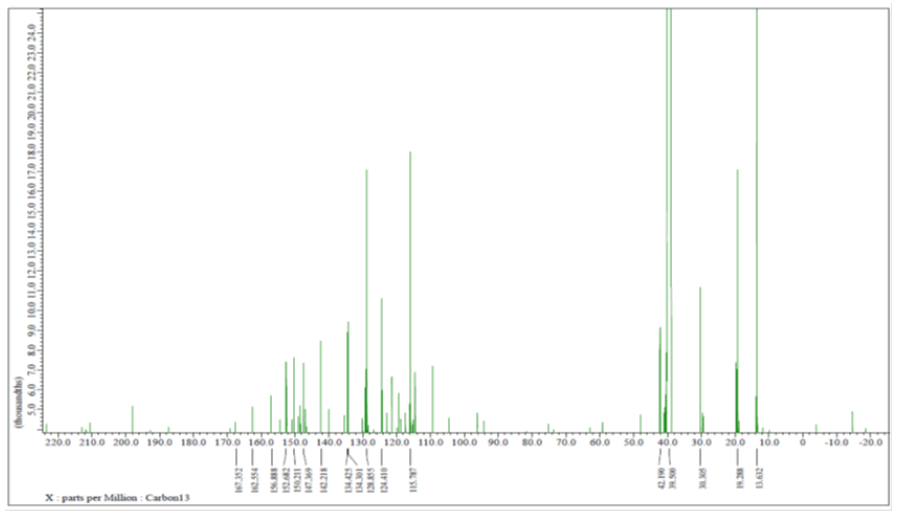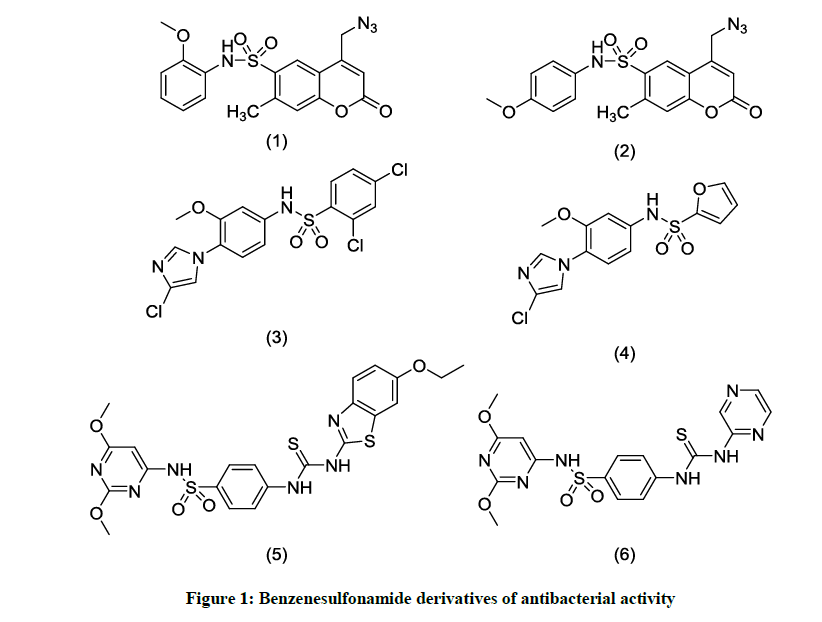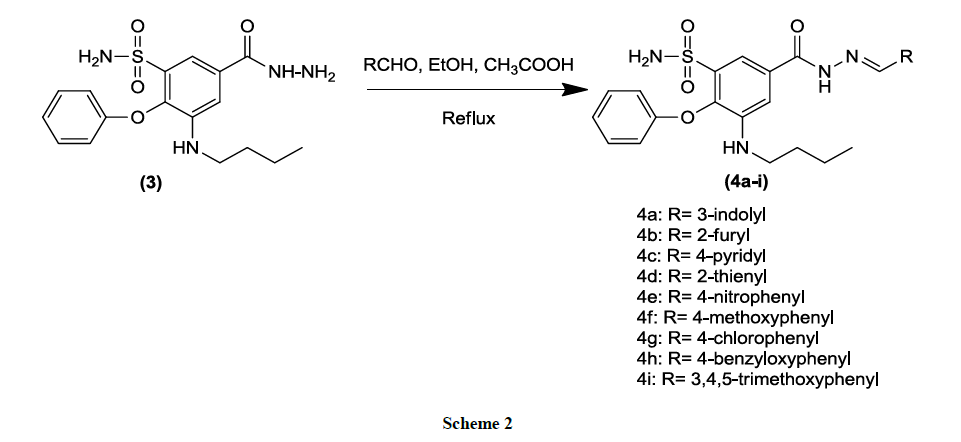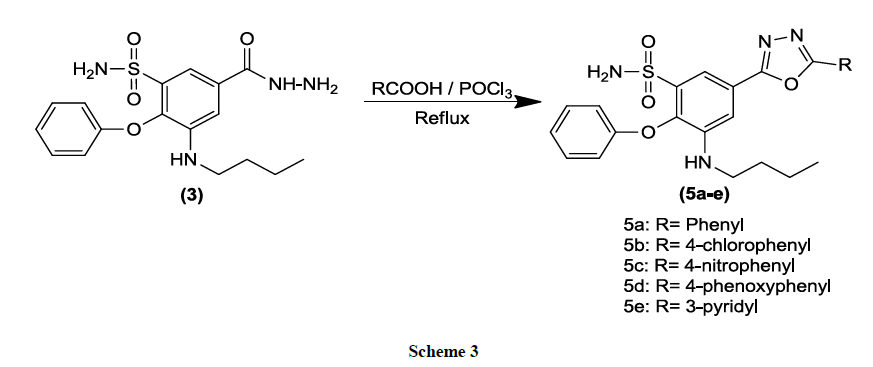Research Article - Der Pharma Chemica ( 2018) Volume 10, Issue 9
Synthesis and Antimicrobial Evaluation of Novel Hydrazones and 1,3,4-Oxadiazoles Incorporating Bumetanide Derivatives
Mustafa I1*, Mostafa SM1, El-Sabbagh OI2,3, Ibrahim TS4,5, Abdulrahman A6 and Bendary MM7
1Department of Pharmaceutical Chemistry, Suez Canal University, Faculty of Pharmacy, Ismailia, Egypt
2Departmentof Medicinal Chemistry, Faculty of Pharmacy, Zagazig University, Zagazig, Egypt
3Department of Pharmaceutical Chemistry, Faculty of Pharmacy, Taif University, Taif, Saudi Arabia
4Department of Pharmaceutical Organic Chemistry, Faculty of Pharmacy, Zagazig University, Zagazig, 44519, Egypt
5Department of Pharmaceutical Chemistry, Faculty of Pharmacy, King Abdulaziz University, Jeddah, 21589, Saudi Arabia
6Department of Pharmaceutical chemistry, Faculty of Pharmacy, Port Said University, Port Said, Egypt
7Department of Microbiology and Immunology, Faculty of Pharmacy, Port Said University, Port Said, Egypt
- *Corresponding Author:
- Mustafa I
Department of Pharmaceutical Chemistry
Suez Canal University
Faculty of Pharmacy
Ismailia, Egypt
Abstract
The aim of this study is to synthesize new benzenesulfonamide derivatives that possess antibacterial activity using Bumetanide as a precursor of benzenesulfonamide. A novel series of hydrazones containing benzenesulfonamides (4a-i) and 1,3,4 oxadiazole containing benzenesulfonamides (5a-e) were prepared and their antibacterial and antifungal activities were measured using microplate broth assay against Gram-positive: Staphylococcus aureus, Gram-negative: Escherichia coli and Pseudomonas aeruginosa and Fungi: Aspergillus fumigates and Candida albicans. The results showed that some of the prepared compounds exhibit a good to excellent activity against the mentioned bacteria, however all the series showed no activity against fungi. Among the series, Compound (4i) demoed an excellent antibacterial activity better than that of the standard reference (Sulfamethoxazole) against Escherichia coli, while compounds (4c, 4e, 4g) showed good activity against all tested bacterial strains equals to Sulfamethoxazole activity. Moreover, compounds (4g, 5d) exert an antimicrobial activity equals to that of Sulfamethoxazole against P. aeruginosa, while compounds (4a, 4b, 4c, 4f, 4g, 4h) exhibit similar activity to Sulfamethoxazole against Escherichia coli.
Keywords
Bumetanide, Hydrazones, 1,3,4-oxadiazole, Antimicrobial activity, Benzenesulfonamide.
Introduction
The antimicrobial resistance has turned into a menace that confronts the community over the last few decades. The use and misuse of antimicrobial agents incited the bacteria to develop resistance against them through different defensive mechanisms like enzymatic degradation, modulation of the drug targets or modifying the bacterial cell membrane permeability [1]. Thus a great number of infectious diseases have become uncontrollable which contributes to high levels of morbidity and mortality [2]. According to the Centers for Disease Control and Prevention (CDC), the resistant bacteria could infect up to two million patients in the United States every year, while around 23000 person of them meet their fate due to the treatment failure [3]. On the other hand, the World Health Organization (WHO) stated that though the antimicrobial agents lose their activity, there are insufficient researches that stand up to this catastrophe which means that our competence to overcome the antimicrobial resistance declines dramatically [4].
The researches in the field of medicinal chemistry evolved a limited number of substantial moieties, frequently present in several drug molecules and interestingly, sulfonamide moiety (SO2NH2) is one of them [5]. Sulfonamides are a pharmacologically active class of drugs that exert different pharmacological activities like antibacterial [6,7], antifungal [8,9], anticarbonic anhydrase [10,11], diuretics [12,13], anti-inflammatory [14,15] and anticancer [16,17]. Among this class of drugs are sulfa drugs that are the first successfully synthesized antimicrobial agents that exert their action via competitive inhibition of folic acid synthesis, and consequently turn off the microbial nucleic acid replication. So far, a group of clinically tried sulfa drugs comprised of benzenesulfonamides bearing antibacterial active aromatic heterocycles are now widely used [5]. For instance, Sulfamethoxazole, Sulfathiazole, Sulfadiazine and Sulfachloropyridazine are composed of benzenesulfonamide conjugated with isoxazole, thiazole, pyrimidine and pyridazine moieties respectively. Thus, new researches were conducted to discover novel benzenesulfonamide derivatives of antimicrobial action to overcome the antimicrobial resistance problem. For example, addition of coumarin ring to benzenesulfonamide contributed to the antimicrobial activity of compounds (1, 2) as displayed in Figure 1 [18]. Moreover, incorporation a chloro substituted imidazole derivative into benzensulfonamide moiety has enhanced antimicrobial and antitubercular activity of compounds (3, 4) shown in figure (1) [19]. Recently, Ghorab et al. [20] could prepare new antimicrobial agents compounds (5,6) through conjugating thioureidobenzensulfonamide moiety with substituted pyrimidine as shown in Figure 1.
On a parallel approach, in the present investigation, we aimed at introducing new antimicrobial agents to face the antimicrobial resistance challenge. Our research is based on incorporation of well reputed antimicrobial moieties like hydrazones [21] and 1,3,4-oxadiazoles [22] into Bumetanide as a precursor of benzenesulfonamide.
Materials and Methods
All starting materials in this investigation from (Sigma-Aldrich, Germany).Melting points (ºC) were determined with a Gallenkamp melting point apparatus (London, UK), and are uncorrected. Elemental analyses (C, H, N, S) were conducted using the Elemental Analyser in the Regional center for Mycology and Biotechnology, Faculty of Science, Al Azhar University, Nasr city, Cairo, Egypt. Proton Nuclear Magnetic Resonance (1H-NMR) and Carbon-13 Nuclear Magnetic Resonance (13C-NMR) were performed in NMR department, Faculty of Science, Al Mansora University. 1H-NMR spectra were recorded on Jeol resonance DELTA2-NMR (500 MHz) (Japan) using dimethyl sulfoxide (DMSO)-d6 as a solvent and tetramethylsilane (TMS) as internal standard (chemical shift in δ, ppm). 13C-NMR spectra were recorded on Jeol resonance DELTA2-NMR (100 MHz) (Japan). All reactions were monitored by Thin Layer Chromatography (TLC) using Silica gel 60 GF245 (E-Merck- Germany) and were visualized by iodine vapors or by UV-lamp at wavelength λ 254 nm.
Methyl 3-(butylamino)-4-phenoxy-5-sulfamoylbenzoate (2, C18H22N2O5S)
To a solution of Bumetanide (1.2 g, 3.2 mmol) in methanol, 1 cm3 of concentrated H2SO4 was slowly added using a glass pipette. The reaction mixture was refluxed at 65°C for 1 h. Allow the reaction mixture to cool to room temperature then pour into a 200 cm3 beaker containing ice water and add 10% Na2CO3 solution till the pH reach approximately 8 with a yield of 88%, M.p=150°C-152°C; 1H-NMR (500 MHz, DMSO-d6) δ (ppm)=0.75 (t, 3H, J=3.5 Hz, CH3), 1.07-1.13 (m, 2H, CH2), 1.32-138 (m, 2H, CH2), 2.49 (s, 2H, SO2NH2), 3.05 (q, 2H, CH2-NH), 3.87 (s, 3H, OCH3), 5.13 (t, 1H, J=6 Hz, NH), 6.83 (d, 2H, J=8 Hz, Ar-H), 7.00 (t, 1H, J=7.5 Hz, Ar-H), 7.25 (t, 2H, J=7.5 Hz, Ar-H), 7.37 (s, 1H, Ar- H), 7.68 (s, 1H, Ar-H) ppm; 13C-NMR(100 MHz, DMSO-d6) δ (ppm)=13.6 (CH2-CH2-CH2-CH3), 19.3 (CH2-CH2-CH2-CH3), 30.1 (CH2-CH2- CH2-CH3), 42.0 (CH2-CH2-CH2-CH3), 52.5 (OCH3), 114.5 (Ar-C), 114.9 (Ar-C), 115.6 (2 Ar-C), 122.3 (Ar-C), 126.9 (Ar-C), 129.1 (Ar-C), 137.9 (2 Ar-C), 139.9 (Ar-C), 142.6 (Ar-C), 156.3 (Ar-C), 165.6 (C=O) ppm; Elemental analysis for (378.44): Calcd:C, 57.13; H, 5.86; N, 7.40, Found: C, 57.38; H, 5.81; N, 7.60 %.
3-(Butylamino)-5-(hydrazinocarbonyl)-2-phenoxy-benzenesulfonamide (3, C17H22N4O4S)
To a solution of compound (2) (1 g, 2.6 mmol) in ethanol (20 cm3), hydrazine hydrate (3 cm3, 61.2 mmol) was added then the mixture was refluxed for 6 hours. After cooling, the formed precipitate was filtered, washed with ethanol, dried then recrystallized from ethanol with a yield 90%, M.p.= 215°C-217°C; 1H-NMR (500 MHz, DMSO-d6) δ: 0.77 (t, 3H, J=3.5 Hz, CH3), 1.01-1.13 (m, 2H, CH2), 1.32-1.38 (m, 2H, CH2), 2.49 (s, 4H, SO2NH2, NH-NH2), 3.06 (q, 2H, CH2- NH), 4.92 (t, 1H, J=6 Hz, NH), 6.82 (d, 2H, J=8 Hz, Ar-H), 6.99 (t, 1H, J=7 Hz, Ar-H), 7.25 (t, 2H, J=7.5 Hz, Ar-H), 7.35 (s, 1H, Ar-H), 7.58 (s, 1H, Ar-H), 9.88 (s, 1H, NH-NH2) ppm; 13C-NMR(100 MHz, DMSO-d6) δ (ppm)=13.7 (CH2-CH2-CH2-CH3), 19.4 (CH2-CH2-CH2-CH3), 30.4 (CH2-CH2-CH2-CH3), 42.0 (CH2-CH2-CH2-CH3), 112.6 (Ar-C), 113.3 (Ar-C), 115.6 (2 Ar-C), 122.2 (Ar-C), 129.1 (Ar-C), 130.6 (2 Ar-C), 137.5 (Ar-C), 138.1 (Ar-C), 142.2 (Ar-C), 156.5 (Ar-C), 165.0 (C=O) ppm; Elemental analysis for (378.45): Calcd: C, 53.95; H, 5.86; N, 14.80, Found: C, 54.31; H, 5.99; N, 14.97 %.
General procedures for synthesis of N'- Arylidene-3-(butylamino)-2-phenoxy-benzenesulfonamide -5-carbonylhydrazide (4a-i)
To a solution of compound (3) (0.5 g, 1.07 mmol) in ethanol (20 cm3), the appropriate aldehyde (0.114 mmol) was added. The reaction mixture was refluxed for 3 hours. The separated solid was filtered, washed with diethyl ether, and crystallized from ethanol.
3-(Butylamino)-5-{2-[(3a,7a-dihydro-1H-indol-3-yl)methylene]hydrazine-1-carbonyl}-2-phenoxybenzenesulfonamide (4a, C26H27N5O4S)
A yield of 87%, M.p=275°C-277°C; 1H-NMR (500 MHz, DMSO-d6) (ppm)=0.78 (t, 3H, J=3 Hz, CH3), 1.12-1.15 (m, 2H, CH2), 1.38-1.41 (m, 2H, CH2), 2.490 (s, 2H, SO2NH2), 3.12 (q, 2H, CH2 next to NH), 5.00 (t, 1H, J=6.5 Hz, NH), 6.87 (d, 2H, J=8 Hz, Ar-H), 7.01 (t, 1H, J=7.5 Hz, Ar-H), 7.16 (t, 1H, J=7.5 Hz, Ar-H), 7.21 (t, 1H, J=8 Hz,CH, indole), 7.27 (t, 2H, J=8 Hz, Ar-H), 7.43 (d, 1H, J=7.4 Hz, Ar-H), 7.45 (s, 1H, Ar-H), 7.66 (s, 1H, Ar-H), 7.84 (s, 1H, Ar-H), 8.30 (d, 1H, J=7.5 Hz, Ar-H), 8.64 (s, 1H, CH=N), 11.62 (s, 2H, CONH, NH of indole) ppm; 13C-NMR (100 MHz, DMSO-d6) δ (ppm)=13.7 (CH2-CH2-CH2-CH3), 19.4 (CH2-CH2-CH2-CH3), 30.3 (CH2-CH2-CH2-CH3), 42.1 (CH2-CH2-CH2-CH3), 111.7 (Ar-C), 111.8 (C3-indole), 113.4 (Ar-C), 115.6 (Ar-C), 120.4 (2 Ar-C), 122.0 (Ar-C), 122.2 (2 Ar-C), 122.7 (Ar-C), 124.3 (Ar-C), 129.1 (2 Ar-C), 130.4 (C2-indole), 131.5 (Ar-C), 137.0 (Ar-C), 137.5 (Ar-C), 138.3 (CH=N), 142.2 (Ar-C), 145.4 (Ar-C), 156.5 (Ar-C), 161.8 (C=O) ppm; Elemental analysis for (505.59): Calcd: C, 61.77; H, 5.38; N, 13.85, Found: C, 61.65; H, 5.44; N, 13.72%.
3-(Butylamino)-5-[2-(furan-2-ylmethylene)-hydrazinecarbonyl]-2-phenoxy-benzenesulfonamide (4b, C22H24N4O5S)
A yield of 82%, M.p.=153°C-155 °C; 1H-NMR (500 MHz, DMSO-d6) δ: 0.77 (t, J=3.5 Hz, 3H, CH3), 1.08-1.11 (m, 2H, CH2), 1.36-1.39 (m, 2H, CH2), 2.49 (s, 2H, SO2NH2), 3.07-3.11 (q, 2H, CH2-NH), 5.02 (t, 1H, J=5.5 Hz, NH), 6.65 (t, 1H, J=5.5 Hz, furan), 6.85 (d, 2H, J=7.5 Hz, Ar-H), 6.95 (d, 1H, J=6 Hz, furan), 7.01 (t, 1H, J=7 Hz, Ar-H), 7.27 (t, 2H, J=7.5 Hz, Ar-H), 7.38 (s, 1H, Ar-H), 7.62 (d, 1H, J=2.5 Hz, CH-O, furan), 7.87 (s, 1H, Ar-H), 8.36 (s, 1H, CH=N), 11.87 (s, 1H, CO-NH) ppm; 13C-NMR (100 MHz, DMSO-d6) δ (ppm)=13.7 (CH2-CH2-CH2-CH3), 19.3 (CH2-CH2-CH2-CH3), 30.3 (CH2-CH2-CH2-CH3), 42.1 (CH2-CH2-CH2-CH3), 112.3 (Ar-C), 113.4 (Ar-C), 113.8 (Ar-C), 115.6 (C4-furan), 122.2 (2 Ar-C), 128.8 (C3-furan), 129.1 (Ar-C), 130.7 (2 Ar-C), 137.6 (CH=N), 137.9 (Ar-C), 138.7 (Ar-C), 142.3 (C5-furan), 145.3 (Ar-C), 149.4 (C2-furan), 156.4 (Ar-C), 162.3 (C=O) ppm; Elemental analysis for (456.51): Calcd: C, 57.88; H, 5.30; N, 12.27, Found: C, 57.84; H, 4.92; N, 11.96%.
3-(Butylamino)-2-phenoxy-5-[2-(pyridin-4-ylmethylene)-hydrazinecarbonyl]-benzenesulfonamide (4c, C23H25N5O4S)
A yield of 91%, M.p.=260°C-264°C; 1H-NMR (500 MHz, DMSO-d6) δ (ppm)=0.77 (t, 3H, J=3 Hz, CH3), 1.09-1.11 (m, 2H, CH2), 1.37- 1.40 (m, 2H, CH2), 2.49 (s, 2H, SO2NH2), 3.09-3.11 (q, 2H, CH2-NH), 5.05-5.07 (t, 1H, J=5.5 Hz, NH), 6.86 (d, 2H, J=8.5 Hz, Ar-H), 7.01 (t, 1H, J=7.5 Hz, Ar-H), 7.27 (t, 2H, J=8 Hz, Ar-H ), 7.41 (s, 1H, Ar-H), 7.66 (s, 1H, Ar-H), 7.68 (d, 2H, J=6.5 Hz, pyridine), 8.47 (s, 1H, CH=N), 8.66 (d, 2H, J=6.5 Hz, pyridine), 12.21 (s, 1H, CO-NH) ppm; 13C-NMR (100 MHz, DMSO-d6) δ (ppm)=13.7 (CH2-CH2-CH2-CH3), 19.3 (CH2-CH2-CH2-CH3), 30.2 (CH2-CH2-CH2-CH3), 42.1 (CH2-CH2-CH2-CH3), 113.6 (Ar-C), 115.6 (Ar-C), 121.0 (2 Ar-C), 122.7 (C3, C5-pyridine), 129.1 (Ar-C), 130.4 (Ar-C), 137.6 (3 Ar-C), 138.9 (Ar-C), 141.4 (C4-pyridine), 142.4 (CH=N), 145.7 (C2, C6-pyridine), 150.3 (Ar-C), 156.4 (Ar-C), 162.7 (C=O) ppm; Elemental analysis for (467.54): Calcd: C, 59.09; H, 5.39; N, 14.98, Found: C, 59.11; H, 5.42; N, 14.90%.
3-(Butylamino)-2-phenoxy-5-[2-(thiophen-2-yl-methylene)-hydrazinecarbonyl]-benzenesulfonamide (4d, C22H24N4O5S)
A yield of 86%, M.p.=218°C-220°C; 1H-NMR (500 MHz, DMSO-d6) δ (ppm)=0.77 (t, 3H, J=3.5 Hz, CH3), 1.09-1.13 (m, 2H, CH2), 1.35-1.39 (m, 2H, CH2), 2.49 (s, 2H, SO2NH2), 3.08-3.11 (q, 2H, CH2-NH), 5.02 (t, 1H, J=6 Hz, NH), 6.85 (d, 2H, J=7.5 Hz, Ar-H), 7.00 (t, 1H, J=7.5 Hz, Ar-H), 7.15 (t, 1H, J=6.5 Hz, thiophene), 7.27 (t, 2H, J=7.5 Hz, Ar-H), 7.39 (s, 1H, Ar-H), 7.48 (d, 1H, J=7 Hz, thiophene), 7.63 (s, 1H, Ar-H), 7.69 (d, 1H, J=6 Hz, thiophene), 8.70 (s, 1H, CH=N), 11.92 (s, 1H, CO-NH) ppm; 13C-NMR (100 MHz, DMSO-d6) δ (ppm)=13.7 (CH2-CH2-CH2-CH3), 19.3 (CH2-CH2-CH2-CH3), 30.3 (CH2-CH2-CH2-CH3), 42.1 (CH2-CH2-CH2-CH3), 113.4 (Ar-C), 113.5 (Ar-C), 115.6 (2 Ar-C), 122.2 (Ar-C), 127.9 (Ar-C), 129.1 (CH=N), 130.8 (C4-thiophene), 131.1 (2 Ar-C, C5-thiophene), 137.6 (C3-thiophene), 138.6 (Ar-C), 139.1 (Ar-C), 142.3 (C2-thiophene), 143.3 (Ar-C), 156.4 (Ar-C), 162.2 (C=O) ppm; Elemental analysis for (472.58): Calcd: C, 55.92; H, 5.12; N, 11.86, Found: C, 55.81; H, 5.36; N, 12.29%.
3-(Butylamino)-5-[2-(4-nitrobenzylidene)-hydrazinecarbonyl]-2-phenoxy-benzenesulfonamide (4e, C24H25N5O6S)
A yield of 93%, M.p.=277°C-281°C; 1H-NMR (500 MHz, DMSO-d6) δ: 0.77 (t, 3H, J=3.5 Hz, CH3), 1.08-1.12 (m, 2H, CH2), 1.34-1.39 (m, 2H, CH2), 2.49 (s, 2H, SO2NH2), 3.09-3.12 (q, 2H, CH2-NH), 5.04 (t, 1H, J=6 Hz, NH), 6.87 (d, 2H, J=7.5 Hz, Ar-H), 7.01 (t, 1H, J=7.5 Hz, Ar-H), 7.28 (t, 2H, J=8 Hz, Ar-H ), 7.33 (s, 1H, Ar-H), 7.58 (s, 1H, Ar-H), 8.11 (d, 2H, J=8 Hz, Ar-H), 8.28 (d, 2H, J=8 Hz, Ar-H), 8.77 (s, 1H,CH=N), 11.089 (s, 1H, CO-NH) ppm; 13C-NMR (100 MHz, DMSO-d6) δ (ppm)=13.6 (CH2-CH2-CH2-CH3), 19.3 (CH2-CH2-CH2-CH3), 30.2 (CH2-CH2-CH2-CH3), 42.0 (CH2-CH2-CH2-CH3), 113.8 (Ar-C), 115.6 (Ar-C), 122.2 (2 Ar-C), 123.6 (Ar-C), 127.6 (3 Ar-C), 129.1 (2 Ar-C), 131.3 (3 Ar-C), 138.6 (Ar-C), 142.1 (Ar-C), 144.2 (Ar-C), 147.7 (CH=N), 152.9 (Ar-C), 156.5 (Ar-C), 162.4 (C=O) ppm; Elemetal analysis for (511.55): Calcd: C, 56.35; H, 4.93; N, 13.69, Found: C, 56.91; H, 5.22; N, 14.09%.
3-(Butylamino)-5-[2-(4-methoxybenzylidene)-hydrazinecarbonyl]-2-phenoxy-benzenesulfonamide (4f, C25H28N4O5S)
A yield of 74%, M.p.=213°C-215°C; 1H-NMR (500 MHz, DMSO-d6) δ (ppm)=0.75-0.78 (t, 3H, J=3.5 Hz, CH3), 1.09-1.13 (m, 2H, CH2), 1.37-1.39 (m, 2H, CH2), 2.49 (s, 2H, SO2NH2), 3.09-3.10 (q, 2H, CH2-NH), 3.81 (s, 3H, OCH3), 5.00 (t, 1H, J=6 Hz, NH), 6.85 (d, 2H, J=8.5 Hz, Ar-H), 7.02 (t, 1H, J=8 Hz, Ar-H), 7.03 (d, 2H, J=8.5 Hz, Ar-H), 7.27 (t, 2H, J=8 Hz, Ar-H), 7.31 (s, 1H, Ar-H), 7.65 (s, 1H, Ar-H), 7.68 (d, 2H, J=8.5 Hz, Ar-H), 8.43 (s, 1H, CH=N), 11.84 (s, 1H, CO-NH) ppm; 13C-NMR (100 MHz, DMSO-d6) δ (ppm)=13.7 (CH2-CH2-CH2-CH3), 19.3 (CH2-CH2-CH2-CH3), 30.3 (CH2-CH2-CH2-CH3), 42.1 (CH2-CH2-CH2-CH3), 55.3 (OCH3), 113.5 (Ar-C), 114.4 (Ar-C), 115.6 (2 Ar-C), 122.2 (2 Ar-C), 126.8 (Ar-C), 128.8 (Ar-C), 129.1 (Ar-C), 131.0 (2 Ar-C), 131.8 (2 Ar-C), 137.5 (Ar-C), 138.6 (Ar-C), 142.3 (Ar-C), 148.1 (CH=N), 156.4 (Ar-C), 160.9 (Ar-C), 162.2 (C=O) ppm; Elemental analysis for (496.58): Calcd: C, 60.47; H, 5.68; N, 11.28, Found: C, 60.77; H, 5.88; N, 11.58%.
3-(Butylamino)-5-[2-(4-chlorobenzylidene)-hydrazinecarbonyl]-2-phenoxy-benzenesulfonamide (4g, C24H25ClN4O4S)
A yield of 86%, M.p. =230°C-234°C; 1H-NMR (500 MHz, DMSO-d6) δ (ppm)=0.75-0.78 (t, 3H, J= 3.5 Hz, CH3), 1.09-1.13 (m, 2H, CH2), 1.35-1.40 (m, 2H, CH2), 2.49 (s, 2H, SO2NH2), 3.08-3.12 (q, 2H, CH2-NH), 5.03 (t, 1H, J=6 Hz, NH), 6.86 (d, 2H, J=7.5 Hz, Ar-H), 7.01 (t, 1H, J=7.5 Hz, Ar-H), 7.27 (t, 2H, J=7.5 Hz, Ar-H ), 7.40 (s, 1H, Ar-H), 7.53 (d, 2H, J=8.5 Hz, Ar-H), 7.65 (s, 1H, Ar-H), 7.77 (d, 2H, J=8.5 Hz, Ar-H), 8.47 (s, 1H,CH=N), 12.00 (s, 1H, CO-NH) ppm; 13C-NMR (100 MHz, DMSO-d6) δ (ppm)=13.6 (CH2-CH2-CH2-CH3), 19.3 (CH2-CH2-CH2-CH3), 30.3 (CH2-CH2-CH2-CH3), 42.1 (CH2-CH2-CH2-CH3), 113.5 (Ar-C), 115.6 (Ar-C), 122.2 (2 Ar-C), 128.8 (Ar-C), 129.0 (Ar-C), 129.1 (3 Ar-C), 130.7 (2 Ar-C), 133.2 (2 Ar-C), 134.6 (Ar-C), 137.6 (Ar-C), 138.7 (Ar-C), 142.3 (Ar-C), 146.8 (CH=N), 156.4 (Ar-C), 162.4 (C=O) ppm; Elemental analysis for (501.00): Calcd: C, 57.54; H, 5.03; N, 11.18, Found: C, 57.81; H, 5.34; N, 11.51%.
5-{2-[4-(benzyloxy)-benzylidene]-hydrazinecarbonyl}-3-(butylamino)-2-phenoxy-benzenesulfonamide (4h, C31H32N4O5S)
A yield of 73%, M.p.=286°C-289°C; 1H-NMR (500 MHz, DMSO-d6) δ (ppm)=0.76 (t, 3H, J=3.5 Hz, CH3), 1.10-1.13 (m, 2H, CH2), 1.35-1.38 (m, 2H, CH2), 2.49 (s, 2H, SO2NH2), 3.07-3.11 (q, 2H, CH2-NH), 5.02 (t, 1H, J=6 Hz, NH), 5.13 (s, 2H, CH2-O), 6.85 (d, 2H, J=7.5 Hz, Ar-H), 6.99 (t, 1H, J=6.5 Hz, Ar-H), 7.01 (d, 2H, J=8.5 Hz, Ar-H), 7.16 (t, 1H, J=6.5 Hz, Ar-H), 7.26 (t, 2H, J=8 Hz, Ar-H), 7.30 (s, 1H, Ar-H), 7.38 (t, 2H, J=7 Hz, Ar-H), 7.43 (d, 2H, J=7 Hz, Ar-H), 7.68 (s, 1H, Ar-H), 7.70 (d, 2H, J=8.5 Hz, Ar-H), 10.65 (s, 1H, CH=N), 11.748 (s, 1H, CO-NH) ppm; 13C-NMR (100 MHz, DMSO-d6) δ (ppm)=13.7 (CH2-CH2-CH2-CH3), 19.4 (CH2-CH2-CH2-CH3), 30.3 (CH2-CH2-CH2-CH3), 42.0 (CH2-CH2-CH2-CH3), 69.3 (O-CH2), 113.8 (Ar-C), 115.1 (Ar-C), 115.6 (2 Ar-C), 118.6 (2 Ar-C), 122.2 (Ar-C), 126.9 (Ar-C), 127.7 (Ar-C), 128.5 (2 Ar-C), 129.1 (Ar-C), 129.9 (2 Ar-C), 130.1 (2 Ar-C), 131.4 (2 Ar-C), 136.0 (Ar-C), 136.8 (Ar-C), 138.6 (Ar-C), 139.3 (Ar-C), 143.9 (CH=N), 156.4 (Ar-C), 164.4 (Ar-C), 168.4 (C=O) ppm; Elemental analysis for (572.67): Calcd: C, 65.02; H, 5.63; N, 9.78, Found: C, 65.37; H, 5.69; N, 9.72%.
3-(Butylamino)-2-phenoxy-5-[2-(3,4,5-trimethoxybenzylidene)-hydrazinecarbonyl]-benzenesulfonamide (4i, C27H32N4O7S)
A yield of 77%, M.p.=254°C-257°C; 1H-NMR (500 MHz, DMSO-d6) δ (ppm)=0.78 (t, 3H, J=3.5 Hz, CH3), 1.09-1.13 (m, 2H, CH2), 1.36-1.41 (m, 2H, CH2), 2.49 (s, 2H, SO2NH2), 3.08-3.11 (q, 2H, CH2-NH), 3.71 (s, 3H, OCH3), 3.84 (s, 6H, 2OCH3), 5.02 (t, 1H, J=6 Hz, NH), 6.86 (d, 2H, J=8 Hz, Ar-H), 7.01 (t, 1H, J=7.5 Hz, Ar-H), 7.03 (s, 2H, Ar-H), 7.27 (t, 2H, J=8 Hz, Ar-H), 7.39 (s, 1H, Ar-H), 7.64 (s, 1H, Ar-H), 8.41 (s, 1H, CH=N), 11.91 (s, 1H, CO-NH) ppm; 13C-NMR (100 MHz, DMSO-d6) δ (ppm)=13.6 (CH2-CH2-CH2-CH3), 19.3 (CH2-CH2-CH2-CH3), 30.3 (CH2-CH2-CH2-CH3), 42.1 (CH2-CH2-CH2-CH3), 56.0 (3, 5 OCH3), 60.1 (4 OCH3), 104.3 (2 Ar-C), 113.5 (Ar-C), 115.6 (Ar-C), 122.2 (2 Ar-C), 129.1 (Ar-C), 129.8 (Ar-C), 130.9 (Ar-C), 137.6 (3 Ar-C), 138.6 (Ar-C), 139.3 (Ar-C), 142.2 (Ar-C), 148.2 (CH=N), 153.2 (2 Ar-C), 156.4 (Ar-C), 162.4 (C=O) ppm; Elemental analysis for (556.63): Calcd: C, 58.26; H, 5.79; N, 10.07, Found: C, 58.23; H, 5.77; N, 10.09%.
General procedures for synthesis of substituted-3-(butylamino)-2-phenoxy-5-(5-aryl-1,3,4-oxadiazol-2-yl)-benzenesulfonamide (5a-e)
To a solution of compound (3) (10 mmol), phosphorus oxychloride and an equivalent amount of aromatic acid (10 mmol) were added and the mixture was refluxed for 24 hours. Excess phosphorus oxychloride was distilled off under reduced pressure and the residue was quenched in ice. Sodium carbonate was added till neutralization takes place and the separated solid was filtered and crystallized from methylene chloride and petroleum ether.
3-(Butylamino)-2-phenoxy-5-(5-phenyl-1,3,4-oxadiazol-2-yl)-benzenesulfonamide (5a, C24H24N4O4S)
A yield of 82%, M.p.=153°C-155°C; 1H-NMR (500 MHz, DMSO-d6) δ (ppm)=0.77 (t, 3H, J=3 Hz, CH3), 1.07-1.15 (m, 2H, CH2), 1.31-1.43 (m, 2H, CH2), 2.49 (s, 2H, SO2NH2), 3.01-3.11 (q, 2H, CH2-NH), 4.66 (t, 1H, J=6 Hz NH), 6.80 (d, 2H, J=8 Hz, Ar-H), 6.94 (t, 1H, J=8 Hz, Ar-H), 7.21 (t, 2H, J=8 Hz, Ar-H), 7.27 (d, 2H, J=7 Hz, Ar-H), 7.33 (s, 1H, Ar-H), 7.54 (t, 1H, J=7 Hz, Ar-H), 7.64 (s, 1H, Ar-H), 7.80 (t, 2H, J=7 Hz, Ar-H) ppm; Elemental analysis for (464.54): Calcd: C, 62.06; H, 5.21; N, 12.06, Found: C, 62.20; H, 5.37; N, 12.17%.
3-(Butylamino)-5-[5-(4-chlorophenyl)-1,3,4-oxadiazol-2-yl]-2-phenoxy-benzenesulfonamide (5b, C24H23ClN4O4S)
A yield of 82%, M.p.=244°C-246°C; 1H-NMR (500 MHz, DMSO-d6) δ (ppm)=0.77 (t, 3H, J=3 Hz, CH3), 1.06-1.11 (m, 2H, CH2), 1.22-1.28 (m, 2H, CH2), 2.49 (s, 2H, SO2NH2), 3.06-3.11 (q, 2H, CH2-NH), 4.91 (t, 1H, J=6 Hz, NH), 6.82 (d, 2H, J=8 Hz, Ar-H), 7.06 (t, 1H, J=8.5 Hz, Ar-H), 7.14 (d, 2H, J=7.5 Hz, Ar-H), 7.23 (s, 1H, Ar-H), 7.29 (t, 2H, J=8 Hz, Ar-H), 7.59 (s, 1H, Ar-H), 7.83 (d, 2H, J=8 Hz, Ar-H) ppm; 13C-NMR (100 MHz, DMSO-d6) δ (ppm)=14.0 (CH2-CH2-CH2-CH3), 19.9 (CH2-CH2-CH2-CH3), 30.4 (CH2-CH2-CH2-CH3), 42.7 (CH2-CH2-CH2-CH3), 112.7 (Ar-C), 116.3 (Ar-C), 117.9 (2 Ar-C), 118.5 (Ar-C), 119.5 (Ar-C), 125.9 (2 Ar-C), 129.6 (2 Ar-C), 129.8 (2 Ar-C), 130.7 (Ar-C), 135.1 (Ar-C), 145.3 (Ar-C), 147.2 (Ar-C), 152.1 (Ar-C), 156.1 (Ar-C), 161.5 (C5-oxadiazole), 161.8 (C2-oxadiazole) ppm. Elemental analysis for (498.98): Calcd: C, 57.77; H, 4.65; N, 11.23, Found: C, 57.80; H, 4.58; N, 11.29%.
3-(Butylamino)-5-[5-(4-nitrophenyl)-1,3,4-oxadiazol-2-yl]-2-phenoxy-benzenesulfonamide (5c, C24H23N5O6S)
A yield of 90%, M.p.=289°C-292°C; 1HNMR (500 MHz, DMSO-d6) δ (ppm)=0.77 (t, 3H, J=3.5 Hz, CH3), 1.00-1.12 (m, 2H, CH2), 1.22-1.38 (m, 2H, CH2), 2.49 (s, 2H, SO2NH2), 3.00-3.10 (q, 2H, CH2-NH), 5.21 (t, 1H, J=6 Hz, NH), 6.88 (d, 2H, J=8.5 Hz, Ar-H), 7.01 (t, 1H, J=8 Hz, Ar-H), 7.28 (t, 2H, J=7.5 Hz, Ar-H), 7.53 (s, 1H, Ar-H), 7.73 (d, 2H, J=8.5 Hz, Ar-H), 7.80 (s, 1H, Ar-H), 8.16 (d, 2H, J=7 Hz, Ar-H) ppm; 13C-NMR (100 MHz, DMSO-d6) δ (ppm)=13.6 (CH2-CH2-CH2-CH3), 19.3 (CH2-CH2-CH2-CH3), 30.6 (CH2-CH2-CH2-CH3), 42.2 (CH2-CH2-CH2-CH3), 128.3 (Ar-C), 129.1 (Ar-C), 130.3 (2 Ar-C), 131.8 (Ar-C), 134.7 (Ar-C), 136.4 (Ar-C), 136.7 (2 Ar-C), 137.7 (2 Ar-C), 138.8 (2 Ar-C), 139.6 (Ar-C), 146.4 (Ar-C), 147.6 (Ar-C), 151.9 (Ar-C), 156.3 (Ar-C), 161.9 (C5-oxadiazole), 162.5 (C2-oxadiazole) ppm; Elemental analysis for (509.53): Calcd: C, 56.57; H, 4.55; N, 13.74, Found: C, 56.36; H, 4.48; N, 13.54%.
3-(Butylamino)-2-phenoxy-5-[5-(4-phenoxyphenyl)-1,3,4-oxadiazol-2-yl]-benzenesulfonamide (5d, C30H28N4O5S)
A yield of 91%, M.p.=326°C-328°C; 1H-NMR (500 MHz, DMSO-d6) δ (ppm)=0.77 (t, 3H, J=3.5 Hz, CH3), 1.01-1.11 (m, 2H, CH2), 1.34-1.37 (m, 2H, CH2), 2.49 (s, 2H, SO2NH2), 3.06-3.08 (q, 2H, CH2-NH), 4.92 (t, 1H, J=6 Hz NH), 6.82 (d, 4H, J=8.5 Hz, Ar-H), 6.99 (t, 1H, J=7.5 Hz, Ar-H), 7.09 (t, 1H, J=7.5 Hz, Ar-H), 7.21 (s, 1H, Ar-H), 7.25 (t, 2H, J=7 Hz, Ar-H), 7.33 (t, 2H, J=7.5 Hz, Ar-H), 7.57 (d, 2H, J=8.5 Hz, Ar-H), 7.68 (s, 1H, Ar-H), 8.01(d, 2H, J=8.5 Hz, Ar-H) ppm; 13C-NMR (100 MHz, DMSO-d6) δ (ppm)=13.6 (CH2-CH2-CH2-CH3), 19.3 (CH2-CH2-CH2-CH3), 30.4 (CH2-CH2-CH2-CH3), 42.0 (CH2-CH2-CH2-CH3), 115.5 (Ar-C), 122.1 (Ar-C), 122.8 (2 Ar-C), 129.1 (2 Ar-C), 129.3 (4 Ar-C), 129.6 (Ar-C), 139.1 (2 Ar-C), 147.1 (Ar-C), 148.3 (4 Ar-C), 156.7 (Ar-C), 157.1 (3 Ar-C), 157.9 (Ar-C), 159.4 (Ar-C), 162.8 (C5-oxadiazole), 165.1 (C2-oxadiazole) ppm; Elemental analysis for (556.63): Calcd: C, 64.73; H, 5.07; N, 10.07, Found: C, 64.23; H, 4.77; N, 9.71%.
3-(Butylamino)-2-phenoxy-5-[5-(pyridin-3-yl)-1,3,4-oxadiazol-2-yl]-benzenesulfonamide (5e, C23H23N5O4S)
A yield of 89%, M.p.= 263°C-265°C; 1H-NMR (500 MHz, DMSO-d6) δ (ppm)=0.78 (t, 3H, J=3.5 Hz, CH3), 1.08-1.11 (m, 2H, CH2), 1.36-1.39 (m, 2H, CH2), 2.49 (s, 2H, SO2NH2), 3.06-3.11 (q, 2H, CH2-NH), 4.67 (t, 1H, J=6 Hz NH), 6.81 (d, 2H, J=8 Hz, Ar-H), 6.94 (t, 1H, J=7.5 Hz, Ar-H), 7.20 (t, 2H, J=7.5 Hz, Ar-H), 7.37 (s, 1H, Ar-H), 7.68 (t, 1H, J=8.5 Hz, pyridine), 7.83 (s, 1H, Ar-H), 8.50 (d, 2H, J=7 Hz, pyridine), 9.32 (s, 1H, pyridine) ppm; 13C-NMR (100 MHz, DMSO-d6) δ (ppm)=13.6 (CH2-CH2-CH2-CH3), 19.3 (CH2-CH2-CH2-CH3), 30.3 (CH2-CH2-CH2-CH3), 42.2 (CH2-CH2-CH2-CH3), 114.5 (Ar-C), 115.8 (Ar-C), 119.2 (2 Ar-C), 121.4 (Ar-C), 124.4 (Ar-C), 128.9 (C3, C5-pyridine), 130.0 (Ar-C), 134.3 (2 Ar-C), 134.4 (C4-pyridine), 142.6 (Ar-C), 147.4 (Ar-C), 150.2 (C6-pyridine), 152.3 (C2-pyridine), 156.9 (C6-pyridine), 162.6 (C5-oxadiazole), 167.4 (C2-oxadiazole) ppm; Elemental analysis for (465.52): Calcd: C, 59.34; H, 4.98; N, 15.04, Found: C, 59.82; H, 5.33; N, 15.43%.
Results and Discussion
Chemistry
The starting material of this investigation is Bumetanide; 3-(butylamino)-4-phenoxy-5-sulfamoylbenzoic acid (1) which was esterified with methanol in presence of sulfuric acid to afford methyl 3-(butylamino)-4-phenoxy-5-sulfamoylbenzoate (2). The ester form (2) underwent hydrazinolysis with hydrazine hydrate in ethanol to yield 3-(butylamino)-5-(hydrazinocarbonyl)-2-phenoxy-benzenesulfonamide (3) as shown in Scheme 1.
The acid hydrazide derivative (3) was condensed with series of different aldehydes to afford N'-arylidene-3-(butylamino)-2-phenoxy-benzenesulfonamide- 5-carbonyl hydrazides (4a-i) as shown in Scheme 2.
On the other hand, compound (3) was condensed with different aromatic acids in presence of phosphorous oxychloride (POCl3) to produce a novel series of oxadiazoles of substituted-3-(butylamino)-2-phenoxy-5-(5-aryl-1,3,4-oxadiazol-2-yl)-benzenesulfonamide (5a-e) as shown in Scheme 3.
The structures of the novel compounds were confirmed from their spectral and micro analytical data. Structure of compound (2) was confirmed by the presence of one singlet signal in 1H-NMR spectrum at 3.87 ppm due to (OCH3) protons. Furthermore, its 13C-NMR spectra revealed one additional signal of aliphatic carbon at 52.5 due to (OCH3) carbon. Formation of compound (3) was indicated in 1H-NMR spectrum by disappearance of singlet signal of (OCH3) protons and appearance of the signals of NHNH2 protons at 2.49 ppm (NH-NH2) and 9.88 ppm (NHNH2), while 13C-NMR spectrum elucidate disappearance of one signal of aliphatic carbon of (OCH3) group which clarifies the nucleophilic substitution reaction. Moreover, the structures of compounds (4a-i) were confirmed by 1H-NMR spectra that showed disappearance of the signal of primary amino group protons (NHNH2) in compound (3) spectrum which proved the condensation with different aldehydes. Moreover, an increase in the number of signals in the aromatic region with one signal corresponding to a methylidene proton at the region between 8.30-8.80 ppm except compound (4h) it exhibited at 10.65 ppm. 13C-NMR spectra of compounds (4a-i) revealed additional signals due to carbons of aromatic rings of different aromatic aldehydes, besides a methylidene carbon of hydrazone at different values between 143.3 and 148.1. In another direction, compounds (5a-e) were demonstrated in 1H-NMR spectra by disappearance of two signals of (NH-NH2) which were present at compound (3) 1H-NMR spectrum at 2.49, 9.88 ppm and appearance of signals of the new aromatic rings protons of different aromatic acids. Moreover, 13C-NMR spectra showed the presence of two carbon signals at the region between 161.1 and 167.4 referring to the C2, C5 of the newly formed 1,3,4 oxadiazole ring and absence of the carbonyl signal of compound (3) which was appeared at 165.0 ppm. Moreover, the 13C-NMR spectra demoed an increase in the number of aromatic signals at the region between 129.0 and 130.0 corresponding to the additional carbons of aromatic acids at position 5 of the oxadiazole ring.
Antimicrobial activity
The antimicrobial activity of the newly synthesized compounds were screened against several pathogenic microbes representative Gram-positive bacteria: Staphyllococcus aureus (RCMB010010), Gram-negative bacteria: P. aeruginosa (RCMB 010049) and E. coli (RCMB 010058) and Fungi: Aspergillus fumigatus (RCMB02568) and Candida albicans (RCMB05036). The microbial suspensions equivalent to the turbidity of 0.5 McFarland (108 CFU/ml) standard were prepared from a fresh subculture of tested bacteria in Mueller Hinton Broth (MHB) and tested fungi in Sabouraud Dextrose Broth (SDB) then this suspension was diluted to 106 CFU/ml using MHB for bacteria and Sabourand dextrose Broth (SDB) for tested fungi. The adjusted microbial inoculums (100 μl) were added to each well of sterile 96-well flat-bottomed micro titer plate containing the tested concentration of tested samples (100 μl/well). As a result,last inoculum concentration of 5×105 CFU/ml was obtained in each well. Three wells containing microbial suspension with no sample using DMSO employed for dissolving the tested compound (Growth control) and two wells containing only media (background control) were included in this plate. Optical densities were measured after 24 h at 37ºC for bacteria and after 48 hours at 28ºC for fungi using a multi-detection microplate reader at The Regional Center for Mycology and biotechnology (sun Rise-Tecan, USA) at 600 nm. Sulfamethoxzole and Amphotericin B were used as standards for Gram positive bacteria, Gram negative bacteria and fungi respectively. The inhibitory percentage of the tested compounds were illustrated in Table 1 [23].
| Tested samples/ M.O. | Fungi | Gram positive bacteria | Gram negative bacteria | ||
|---|---|---|---|---|---|
| Aspergillus fumigatus (RCMB 02568) | Candida albicans (RCMB 05036) | Staphyllococcus aureus (RCMB010010) | P. aeruginosa (RCMB 010043) | Escherichia coli (RCMB 010052) | |
| Standards | Amphotericin B | Sulfamethoxazole | |||
| 90.31 ± 0.58 | 95.21 ± 0.44 | 90.32 ± 0.68 | 72.12 ± 0.32 | 85.75 ± 0.56 | |
| Bumetanide | NA | NA | 45.66 ± 0.83 | 34.42 ± 0.69 | 38.61 ± 0.69 |
| 2 | NA | NA | 18.24 ± 0.87 | 22.14 ± 0.66 | 27.17 ± 0.60 |
| 3 | NA | NA | 38.13 ± 0.92 | 18.28 ± 0.69 | 24.25 ± 0.76 |
| 4a | NA | NA | 26.24 ± 0.94 | 12.67 ± 0.74 | 84.62 ± 0.66 |
| 4b | NA | NA | 22.25 ± 0.88 | 19.32 ± 0.70 | 85.21 ± 0.59 |
| 4c | NA | NA | 89.68 ± 0.58 | 74.37 ± 0.73 | 83.89 ± 0.44 |
| 4d | NA | NA | 19.21 ± 0.91 | 12.21 ± 0.77 | 71.08 ± 0.58 |
| 4e | NA | NA | 68.26 ± 0.68 | 68.56 ± 0.55 | 62.38 ± 0.74 |
| 4f | NA | NA | 26.25 ± 0.94 | 12.34 ± 0.88 | 86.26 ± 0.58 |
| 4g | NA | NA | 84.32 ± 0.89 | 76.34 ± 0.52 | 85.52 ± 0.61 |
| 4h | NA | NA | 32.14 ± 0.97 | 22.03 ± 0.72 | 82.14 ± 0.54 |
| 4i | NA | NA | 27.14 ± 0.74 | 19.14 ± 0.68 | 95.26 ± 0.32 |
| 5a | NA | NA | 12.35 ± 0.87 | 23.21 ± 0.91 | 11.14 ± 0.79 |
| 5b | NA | NA | 18.23 ± 0.88 | 13.37 ± 0.79 | 82.14 ± 0.66 |
| 5c | NA | NA | 14.29 ± 0.99 | 9.14 ± 0.92 | 74.25 ± 0.62 |
| 5d | NA | NA | 21.17 ± 0.82 | 70.74 ± 0.59 | 14.22 ± 0.78 |
| 5e | NA | NA | 10.34 ± 0.94 | 18.14 ± 0.83 | 11.13 ± 0.90 |
N.A.: no activity
Table 1: Mean of inhibitory % ± standard derivation produced on a range of clinically pathogenic microorganisms using (125 μg) concentration of tested samples and results are depicted in the following table
Determination of minimum inhibitory concentration (MIC) and inhibitory concentration 50 (IC50)
The antibacterial activities of the tested compounds were studied adopting the broth micro dilution method [24] using Mueller Hinton brothatthe department of microbiology, Faculty of pharmacy, Port Said University. The inoculums of 3 different clinical isolates including Gram-positive bacteria: Staphyllococcus aureus (RCMB010010), Gram-negative bacteria: P. aeruginosa (RCMB 010049) and E. coli (RCMB 010058) and Fungi: Aspergillusfumigatus(RCMB 02568) and Candida albicans (RCMB 05036). The microbial suspensions equivalent to the turbidity of 0.5 McFarland (108 CFU/ml) standard were prepared from a fresh subculture of tested bacteria in Mueller Hinton Broth (MHB) and tested fungi in Sabouraud Dextrose Broth (SDB) then this suspension was diluted to 106 CFU/ml using MHB for bacteria and Sabourand dextrose Broth (SDB) for tested fungi. The adjusted microbial inoculums (100 μl) were added to each well of sterile 96-well flat-bottomed micro titer plate containing the tested concentration of tested samples (100 μl/well). As a result, last inoculum concentration of 5×105 CFU/ml was obtained in each well. Three wells containing microbial suspension with no sample using DMSO (Sigma-Aldrich, Germany) employed for dissolving the tested compound (Growth control) and two wells containing only media (background control) were included in this plate. Optical densities were measured after 24 h at 37ºC for bacteria and after 48 h at 28○C for fungi using a multi-detection microplate reader at 600 nm. Sulfamethoxazole and Amphotericin B were used as standards for Gram positive bacteria, Gram negative bacteria and Fungi respectively. The inhibitory percentage of the tested compounds was illustrated in Table 2. IC50 for each compound were measured during measuring the MIC, The values of IC50 IC50 for each compound were measured during measuring the MIC. The values of IC50 were illustrated in Table 3.
| Tested samples/ M.O. | Fungi | Gram positive bacteria | Gram negative bacteria | |||
|---|---|---|---|---|---|---|
| Aspergillus fumigatus (RCMB 02568) | Candida albicans (RCMB 05036) | Staphylococcus aureus (RCMB010010) | Pseudomonas aeruginosa (RCMB 010043) | Escheichia coli (RCMB010052) | ||
| Standards | Amphotericin B | Sulfamethoxazole | ||||
| 1.2 | 0.6 | 6.4 | 12.8 | 12.8 | ||
| Bumetanide | NA | NA | >100 | >100 | >100 | |
| 2 | NA | NA | >100 | >100 | >100 | |
| 3 | NA | NA | >100 | >100 | >100 | |
| 4a | NA | NA | >100 | >100 | 12.8 | |
| 4b | NA | NA | >100 | >100 | 12.8 | |
| 4c | NA | NA | 12.8 | 25.6 | 12.8 | |
| 4d | NA | NA | >100 | >100 | 25.6 | |
| 4e | NA | NA | 51.2 | 25.6 | 51.2 | |
| 4f | NA | NA | >100 | >100 | 12.8 | |
| 4g | NA | NA | 25.6 | 12.8 | 12.8 | |
| 4h | NA | NA | >100 | >100 | 12.8 | |
| 4i | NA | NA | >100 | >100 | 6.4 | |
| 5a | NA | NA | >100 | >100 | >100 | |
| 5b | NA | NA | >100 | >100 | 51.2 | |
| 5c | NA | NA | >100 | >100 | 25.6 | |
| 5d | NA | NA | >100 | 12.8 | >100 | |
| 5e | NA | NA | >100 | >100 | >100 | |
N.A.: no activity
Table 2: Antimicrobial Activity as MIC (μg/ml) of tested samples against tested microorganism
| Tested samples/ M.O. | Fungi | Gram positive bacteria | Gram negative bacteria | ||
|---|---|---|---|---|---|
| Aspergillus fumigatus (RCMB 02568) | Candida albicans (RCMB 05036) | Staphylococcus aureus (RCMB010010) | Pseudomonas aeruginosa (RCMB 010043) | Escherichia coli (RCMB 010052) | |
| Standards | Amphotericin B | Sulfamethoxazole | |||
| 9.2 | 2.1 | 13.07 | 32.9 | 29.8 | |
| Bumetanide | NA | NA | >100 | >100 | >100 |
| 2 | NA | NA | >100 | >100 | >100 |
| 3 | NA | NA | >100 | >100 | >100 |
| 4a | NA | NA | >100 | >100 | 30.1 |
| 4b | NA | NA | >100 | >100 | 29.4 |
| 4c | NA | NA | 31.3 | 54.9 | 26.2 |
| 4d | NA | NA | >100 | >100 | 42.7 |
| 4e | NA | NA | >100 | 45.5 | 99.8 |
| 4f | NA | NA | >100 | >100 | 38.5 |
| 4g | NA | NA | 45.7 | 19.9 | 20.6 |
| 4h | NA | NA | >100 | >100 | 32.2 |
| 4i | NA | NA | >100 | >100 | 17.8 |
| 5a | NA | NA | >100 | >100 | >100 |
| 5b | NA | NA | >100 | >100 | >100 |
| 5c | NA | NA | >100 | >100 | 69.8 |
| 5d | NA | NA | >100 | 17.5 | >100 |
| 5e | NA | NA | >100 | >100 | >100 |
N.A.: no activity
Table 3: Antimicrobial Activity as IC50 (μg/ml) of tested samples against tested microorganism
The results clarified that all of tested compounds had no activity against the used fungal strains. Most of the newly synthesized compounds show significant antibacterial activity against E. coli and P. aeruginosa with MIC values ranging from 6.4 to 51.2 μg/ml. However, compounds (4c, 4e, 4g) showed activity against all tested bacterial strains. Interestingly, compound (4i) showed an excellent antibacterial activity against E. coli (6.4 μg/ml) that exceed Sulfamethoxazole reference standard (12.8 μg/ml). Moreover, compounds (4a, 4b, 4c, 4f, 4g, 4h) showed similar activity to Sulfamethoxazole against E. coli (12.8 μg/ml). Furthermore, compounds (4g, 5d) exert similar activity to Sulfamethoxazole against P. aeruginosa (12.8 μg/ml). Compounds (1, 2, 3, 5a, 5e) did not exhibit any activity against all the tested strains.
The structure activity relationship (SAR) analysis revealed that benzenesulfonamides bearing hydrazone moieties carrying electron-withdrawing groups or atoms like pyridine (N), Nitro and Chloro at position 4 as compounds (4c, 4e, 4g) conferred a significant antibacterial activity against all the tested bacterial strains. While compounds possessing electron-donating groups like 3-indolyl, 2-furyl, 2-thienyl, methoxy, benzyloxy or timethoxy as compounds (4a, 4b, 4d, 4f, 4h, 4i) exhibited antibacterial activity against E. coli only. On the other side, benzenesulfonamides bearing oxadiazoles having electron-withdrawing groups like Chloro and Nitro at position 4 of the aromatic ring as compounds (5b, 5c) exhibit a good antibacterial effect against E. coli only, while only compounds attached to electron-donating groups at position 4 of aromatic ring like phenoxy group as compound (5d) resulted in a good activity against P. aeruginosa.
Conclusion
We have synthesized a series of benzenesulfonamides bearing hydrazones and benzenesulfonamides bearing oxadiazoles. The investigation of antibacterial screening data reveals that the synthesized compounds showed promising antibacterial activity to both Gram-positive and Gram-negative species. Compound (4i) exerts higher antibacterial activity than sulfamethoxazole against Escherichia coli. Many compounds showed equivalent antibacterial activity to Sulfamethoxazole either against E. coli as compounds (4a, 4b, 4c, 4f, 4g, 4h) or against P. aeruginosa like compounds (4g, 5d). Moreover, there was no any antifungal activity for all tested samples. Hence, the newly synthesized compounds could be considered for further improvement as lead compounds in the future to develop more potent antibacterial agents.
Acknowledgement
The authors thank Faculty of Science, El Mansora University NMR analytical data. We are grateful for Dr. Mohammed Refaat for his contribution to us in this work and his remarkable effort.
References
- A.M. Sefton, Drugs., 2002, 62(4), 557-566.
- A.M. El-Sayed, S.M. Ibrahim, M.K. Soltan, M.E. Abo-Kul, Med. Chem. Res., 2017, 26(6), 1107-1116.
- Centers for Disease Control and Prevention. ANTIBIOTIC RESISTANCE THREATS in the United States, 2013, 2013, 11.
- WHO, Antibiotic resistance, Fact Sheet, Media centre, 2017.
- F. Carta, A. Scozzafava, C.T. Supuran, Expert Opin. Ther. Pat., 2012, 22(7),747-758.
- A. Kamal, P. Swapna, R.V.C.R.N.C. Shetti, A.B. Shaik, M.P. Narasimha Rao, S. Gupta, Eur. J. Med. Chem., 2013, 62, 661-669.
- H.Z. Zhang, S.C. He, Y.J. Peng, H.J. Zhang, L. Gopala, V.K.R. Tangadanchu, Eur. J. Med. Chem., 2017, 136, 165-183.
- A.K. Saha, L. Liu, P. Marichal, F. Odds, Bioorg. Med. Chem. Lett., 2000, 10(24), 2735-2739.
- M. Zareef, R. Iqbal, N.A. Al-Masoudi, J.H. Zaidi, M. Arfan, S.A. Shahzad, Phosphorus Sulfur Silicon Relat. Elem., 2007, 182(2), 281-298.
- A.K. Saluja, M. Tiwari, D. Vullo, C.T. Supuran, Bioorg. Med. Chem. Lett., 2014, 24(5), 1310-1314.
- E. Havránková, J. Csöllei, D. Vullo, V. Garaj, P. Pazdera, C.T. Supuran, Bioorg. Chem., 2018, 77, 25-37.
- V. Cecchetti, F. Schiaffella, O. Tabarrini, W. Zhou, A. Fravolini, A. Goi, Eur. J. Med. Chem., 1991, 26(4), 381-386.
- A.M. Alafeefy, F. Carta, M. Ceruso, A.M.S. Al-Tamimi, A.A. Al-Kahtani, C.T. Supuran, Bioorg. Med. Chem., 2016, 24(6), 1402-1407.
- A.P. Keche, G.D. Hatnapure, R.H. Tale, A.H. Rodge, S.S. Birajdar, V.M. Kamble, Bioorg. Med. Chem. Lett., 2012, 22(10), 3445-3448.
- M.M. Lobo, S.M. Oliveira, I. Brusco, P. Machado, L.F.S.M. Timmers, O.N. de Souza, Eur. J. Med. Chem., 2015, 102, 143-152.
- M.S. Al-Dosari, M.M. Ghorab, M.S. AlSaid, Y.M. Nissan, A.B. Ahmed, Eur. J. Med. Chem., 2013, 69, 373-383.
- A.M. Alafeefy, R. Ahmad, M. Abdulla, W.M. Eldehna, A.M.S. Al-Tamimi, H.A. Abdel-Aziz, Eur. J. Med. Chem., 2016, 109, 247-253.
- M. Basanagouda, K. Shivashankar, M.V. Kulkarni, V.P. Rasal, H. Patecl, S.S. Mutha, Eur. J. Med. Chem., 2010, 45, 1151-1117.
- P.K. Ranjith, R. Pakkath, K.R. Haridas, S.N. Kumari, Eur. J. Med. Chem., 2014, 71, 354-365.
- M.M. Ghorab, M.S. Alsaid, M.S.A. El-Gaby, N.A. Safwat, M.M. Elaasser, A.M. Soliman, Eur. J. Med. Chem., 2016, 122, 299-310.
- S.G. Küçükgüzel, A. Mazi, F. Sahin, S. Öztürk, Eur. J. Med. Chem., 2003, 38(11-12), 1005-1113. 22. A.A. Othman, M. Kihel, S. Amara, Arab. J. Chem., 2014.
- E.G. Kaya, H. Özbilge, S. Albayrak, ANKEM Derg., 2009, 3(23), 110-114.
- C. Valgas, S.M. de Souza, E.F.A. Smânia, A. Smânia Jr., scielo., 2007, 38, 369-80.
Supporting Information
Methyl 3-(butylamino)-4-phenoxy-5-sulfamoylbenzoate (2)
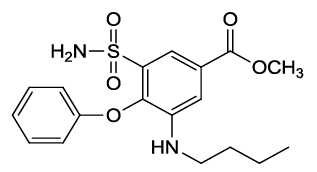
1H-NMR (500 MHz, DMSO-d6) δ (ppm)=0.75 (t, 3H, CH3), 1.01 (m, 2H, CH2), 1.35 (m, 2H, CH2), 2.49 (s, 2H, SO2NH2), 3.05 (q, 2H, CH2- NH), 3.87 (s, 3H, OCH3), 5.13 (t, 1H, NH), 6.83 (d, 2H, J = 8 Hz, Ar-H), 7.00 (t, 1H, J = 7.5 Hz, Ar-H), 7.25 (t, 2H, J = 7.5 Hz, Ar-H), 7.37 (s, 1H, Ar-H), 7.68 (s, 1H, Ar-H) ppm.
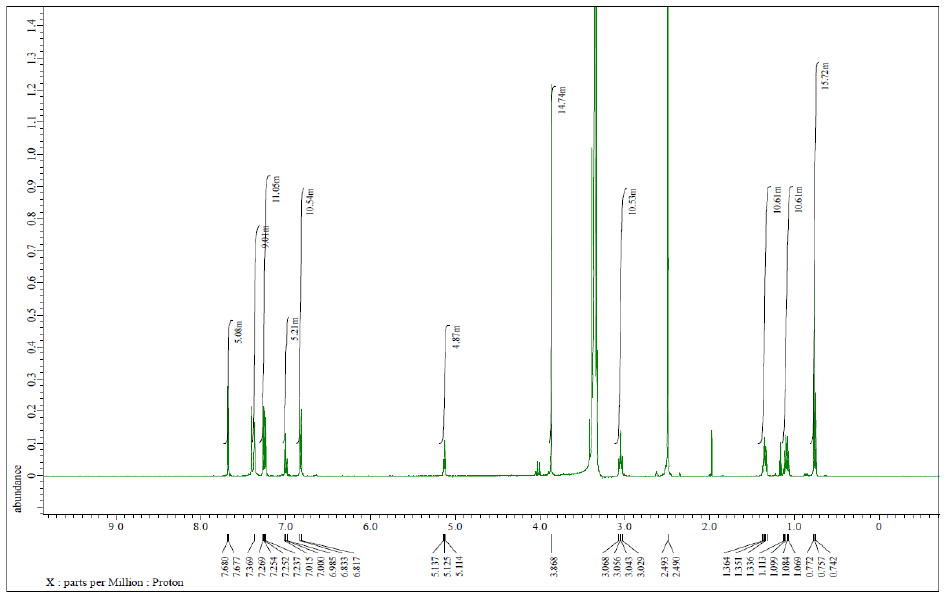
13C-NMR (100 MHz, DMSO-d6) δ (ppm)=13.6 (CH2-CH2-CH2-CH3), 19.3 (CH2-CH2-CH2-CH3), 30.1 (CH2-CH2-CH2-CH3), 42.0 (CH2-CH2- CH2-CH3), 52.5 (OCH3), 114.5 (Ar-C), 114.9 (Ar-C), 115.6 (2 Ar-C), 122.3 (Ar-C), 126.9 (Ar-C), 129.1 (Ar-C), 137.9 (2 Ar-C), 139.9 (Ar-C), 142.6 (Ar-C), 156.3 (Ar-C), 165.6 (C=O) ppm.
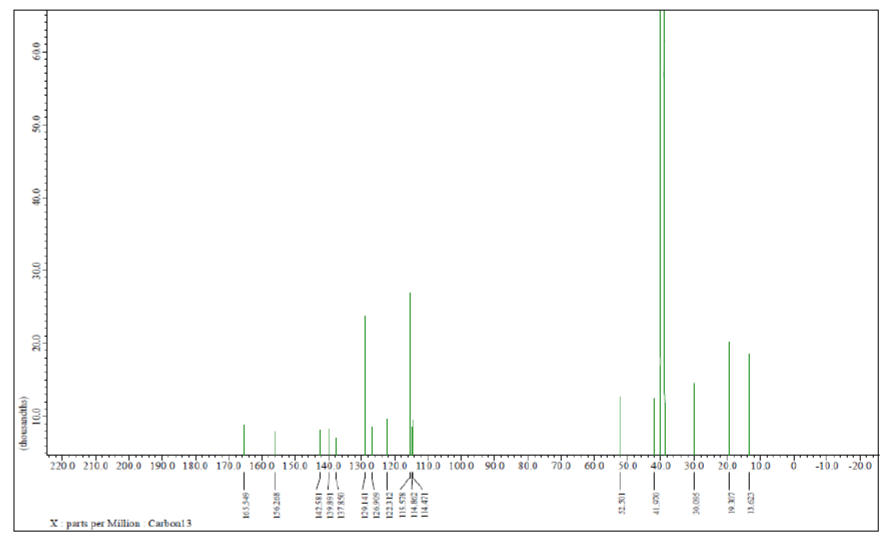
3-(Butylamino)-5-(hydrazinocarbonyl)-2-phenoxybenzenesulfonamide (3)
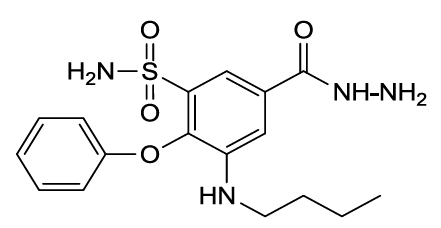
1H-NMR (500 MHz, DMSO-d6) δ (ppm)=0.77 (t, 3H, CH3), 1.11 (m, 2H, CH2), 1.34 (m, 2H, CH2), 2.49 (s, 4H, SO2NH2, NH-NH2), 3.06(q, 2H, CH2- NH), 4.92 (t, 1H, NH), 6.82 (d, 2H, J = 8 Hz, Ar-H), 6.99 (t, 1H, J = 7 Hz, Ar-H), 7.25 (t, 2H, J = 7.5 Hz, Ar-H), 7.35 (s, 1H, Ar-H), 7.58 (s, 1H, Ar-H), 9.88 (s, 1H, NH-NH2) ppm.
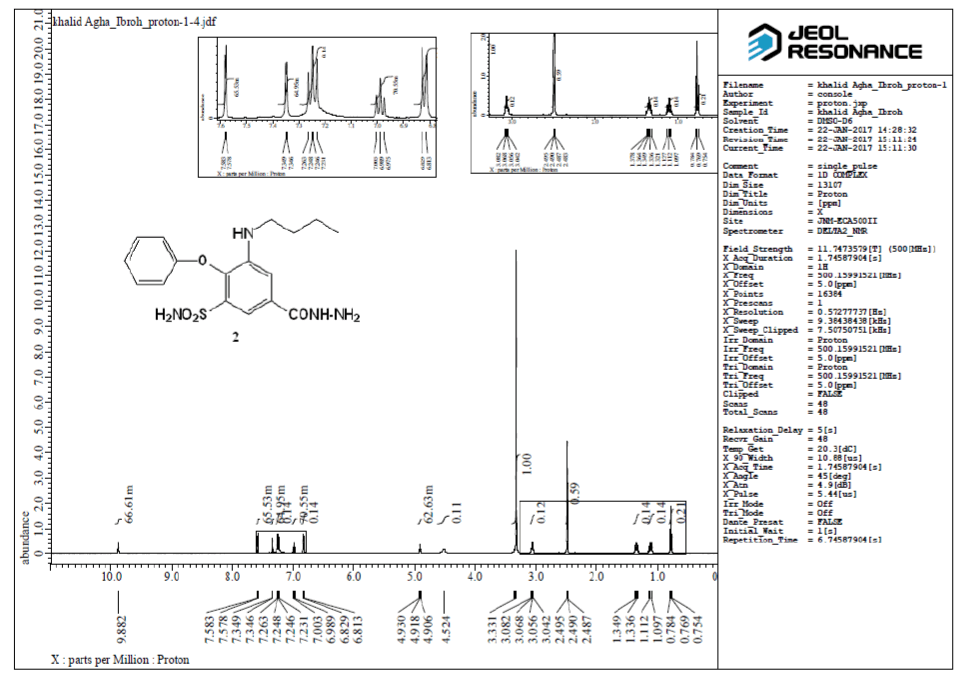
13C-NMR (100 MHz, DMSO-d6) δ: 13.7 (CH2-CH2-CH2-CH3), 19.4 (CH2-CH2-CH2-CH3), 30.4 (CH2-CH2-CH2-CH3), 42.0 (CH2-CH2-CH2- CH3), 112.6 (Ar-C), 113.3 (Ar-C), 115.6 (2 Ar-C), 122.2 (Ar-C), 129.1 (Ar-C), 130.6 (2 Ar-C), 137.5 (Ar-C), 138.1 (Ar-C), 142.2 (Ar-C), 156.5 (Ar-C), 165.0 (C=O) ppm.
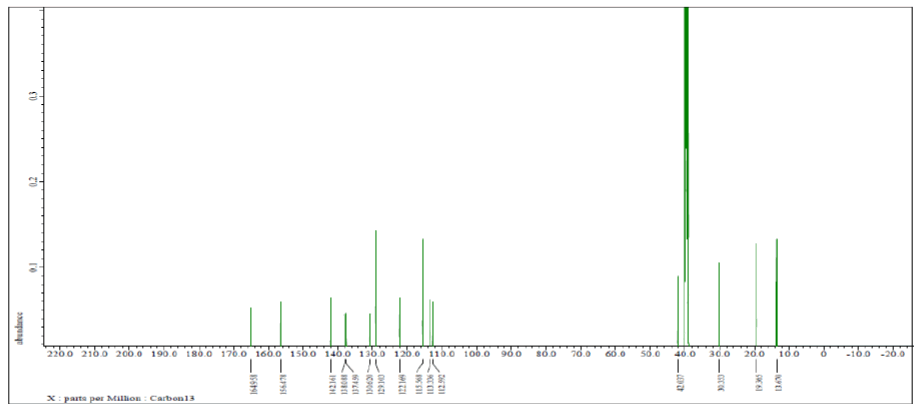
{2-[(1H-indol-3-yl)-methylene]-hydrazinecarbonyl}-3-(butylamino)-2-phenoxy-benzenesulfonamide (4a)
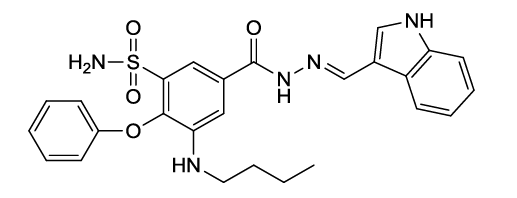
1H-NMR (500 MHz, DMSO-d6) δ (ppm)=0.78 (t, 3H, CH3), 1.13 (m, 2H, CH2), 1.40 (m, 2H, CH2), 2.490 (s, 2H, SO2NH2), 3.12 (q, 2H, CH2 next to NH), 5.00 (t, 1H, NH), 6.87 (d, 2H, J = 8 Hz, Ar-H), 7.01 (t, 1H, J = 7.5 Hz, Ar-H), 7.16 (t, 1H, J = 7.5 Hz, Ar-H), 7.21 (t, 1H, CH, indole), 7.27 (t, 2H, J = 8 Hz, Ar-H), 7.43 (d, 1H, J = 7.4 Hz, Ar-H), 7.45 (s, 1H, Ar-H), 7.66 (s, 1H, Ar-H), 7.84 (s, 1H, Ar-H), 8.30 (d, 1H, J = 7.5 Hz, Ar-H), 8.64 (s, 1H, CH=N), 11.62 (s, 2H, CONH, NH of indole) ppm.
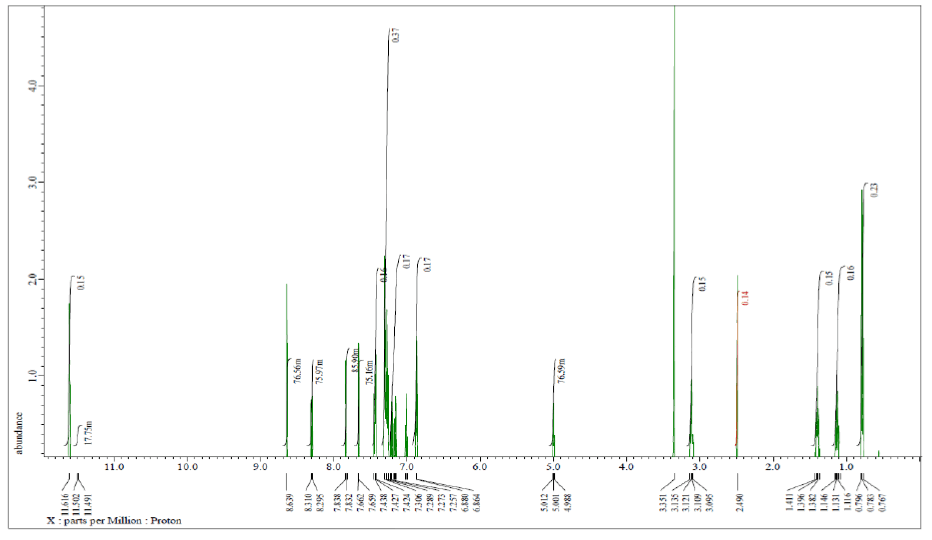
13C-NMR (100 MHz, DMSO-d6) δ (ppm)=13.7 (CH2-CH2-CH2-CH3), 19.4 (CH2-CH2-CH2-CH3), 30.3 (CH2-CH2-CH2-CH3), 42.1 (CH2-CH2- CH2-CH3), 111.7 (Ar-C), 111.8 (C3-indole), 113.4 (Ar-C), 115.6 (Ar-C), 120.4 (2 Ar-C), 122.0 (Ar-C), 122.2 (2 Ar-C), 122.7 (Ar-C), 124.3 (Ar- C), 129.1 (2 Ar-C), 130.4 (C2-indole), 131.5 (Ar-C), 137.0 (Ar-C), 137.5 (Ar-C), 138.3 (CH=N), 142.2 (Ar-C), 145.4 (Ar-C), 156.5 (Ar-C), 161.8 (C=O) ppm.
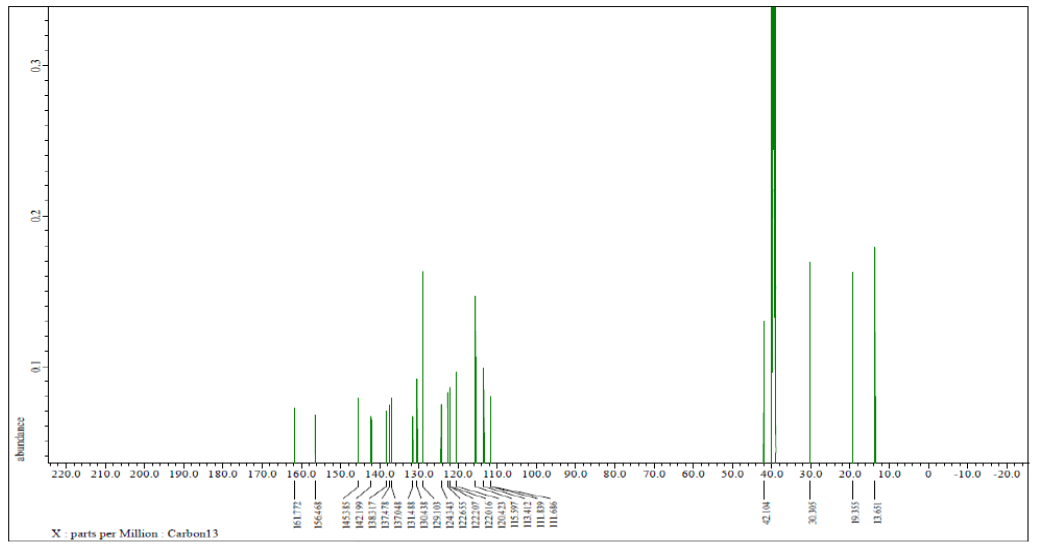
3-(Butylamino)-5-[2-(furan-2-ylmethylene)-hydrazinecarbonyl]-2-phenoxy-benzenesulfonamide (4b)
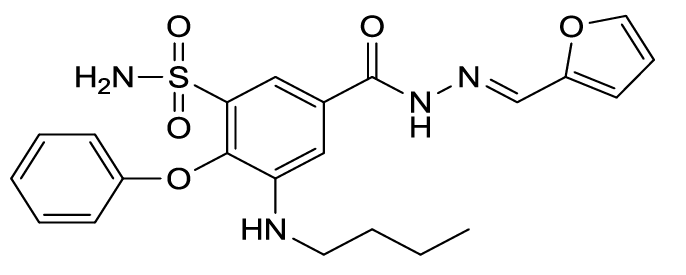
1H-NMR (500 MHz, DMSO-d6) δ (ppm)=0.77 (t, 3H, CH3), 1.1 (m, 2H, CH2), 1.38 (m, 2H, CH2), 2.49 (s, 2H, SO2NH2), 3.09 (q, 2H, CH2-NH), 5.02 (t, 1H, NH), 6.65 (t, 1H, furan), 6.85 (d, 2H, J = 7.5 Hz, Ar-H), 6.95 (d, 1H, furan), 7.01 (t, 1H, J = 7 Hz, Ar-H), 7.27 (t, 2H, J = 7.5 Hz, Ar- H), 7.38 (s, 1H, Ar-H), 7.62 (d, 1H, CH-O, furan), 7.87 (s, 1H, Ar-H), 8.36 (s, 1H, CH=N), 11.87 (s, 1H, CO-NH) ppm.
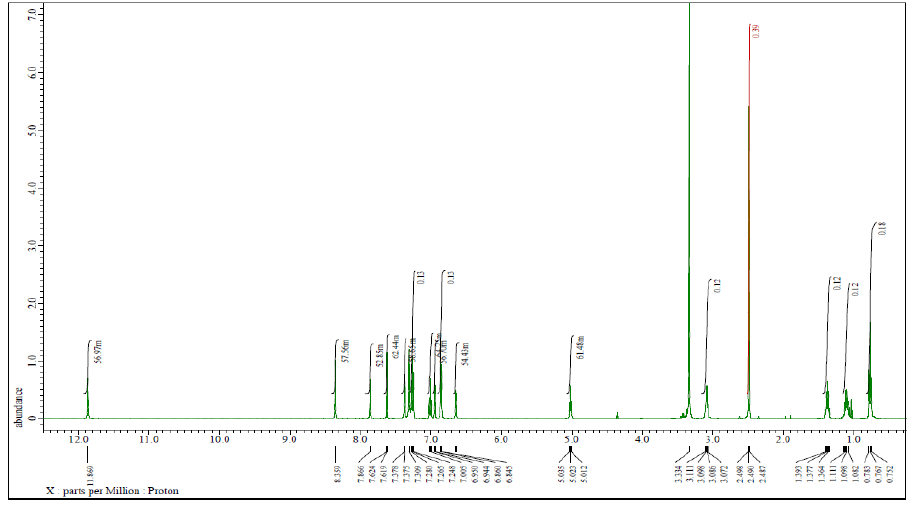
13C-NMR (100 MHz, DMSO-d6) δ (ppm)=13.7 (CH2-CH2-CH2-CH3), 19.3 (CH2-CH2-CH2-CH3), 30.3 (CH2-CH2-CH2-CH3), 42.1 (CH2-CH2- CH2-CH3), 112.3 (Ar-C), 113.4 (Ar-C), 113.8 (Ar-C), 115.6 (C4-furan), 122.2 (2 Ar-C), 128.8 (C3-furan), 129.1 (Ar-C), 130.7 (2 Ar-C), 137.6 (CH=N), 137.9 (Ar-C), 138.7 (Ar-C), 142.3 (C5-furan), 145.3 (Ar-C), 149.4 (C2-furan), 156.4 (Ar-C), 162.3 (C=O) ppm.
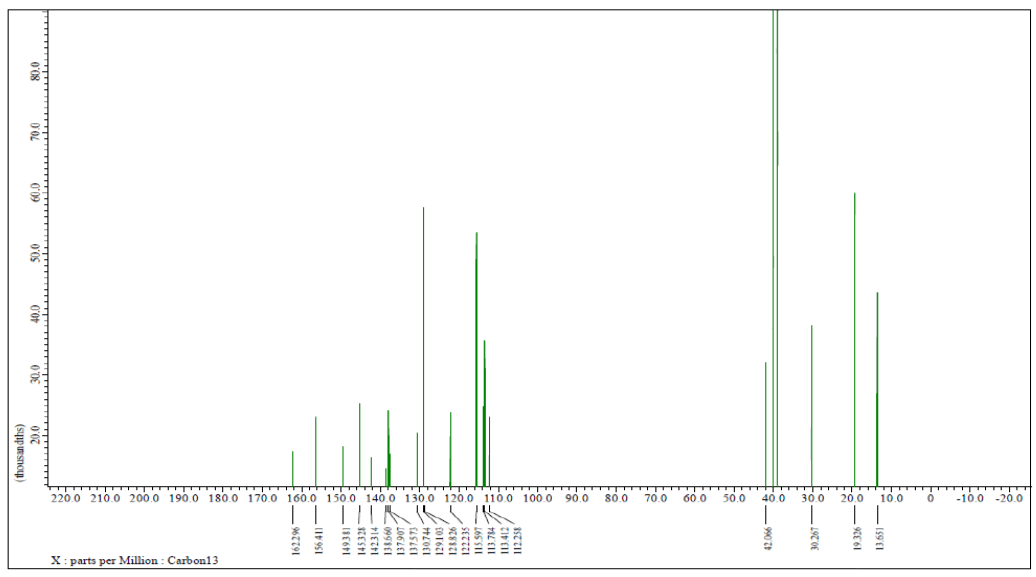
3-(Butylamino)-2-phenoxy-5-[2-(pyridin-4-ylmethylene)-hydrazinecarbonyl]-benzenesulfonamide (4c)
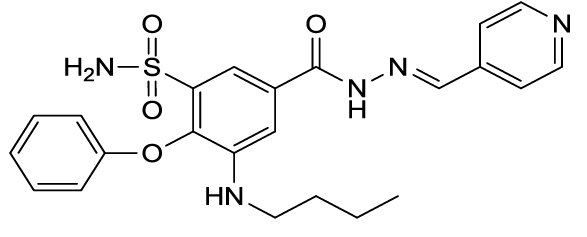
1H-NMR (500 MHz, DMSO-d6) δ (ppm)=0.77 (t, 3H, CH3), 1.11 (m, 2H, CH2), 1.38 (m, 2H, CH2), 2.49 (s, 2H, SO2NH2), 3.10 (q, 2H, CH2- NH), 5.06 (t, 1H, NH), 6.86 (d, 2H, J = 8.5 Hz, Ar-H), 7.01 (t, 1H, J = 7.5 Hz, Ar-H), 7.27 (t, 2H, J = 8 Hz, Ar-H ), 7.41 (s, 1H, Ar-H), 7.66 (s, 1H, Ar-H), 7.68 (d, 2H, pyridine), 8.47 (s, 1H, CH=N), 8.66 (d, 2H, pyridine), 12.21 (s, 1H, CO-NH) ppm.
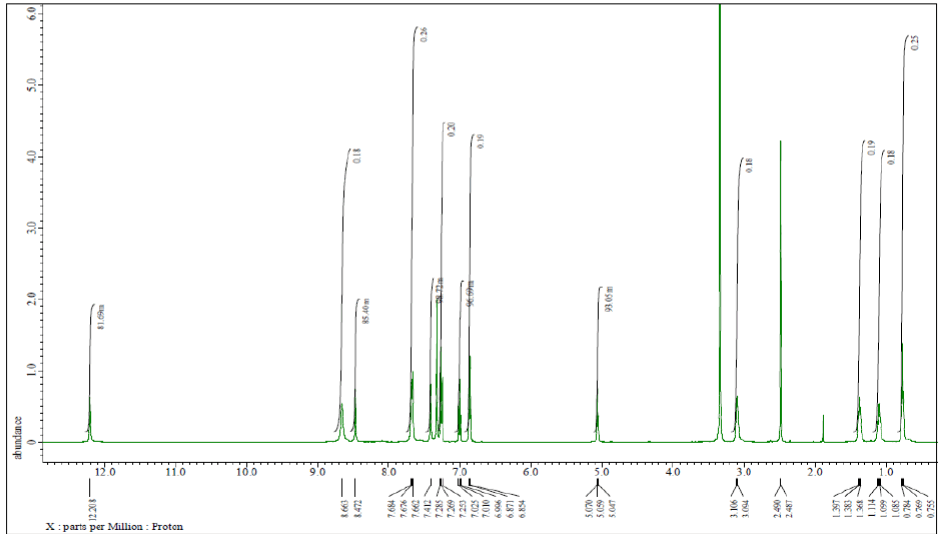
13C-NMR (100 MHz, DMSO-d6) δ (ppm)=13.7 (CH2-CH2-CH2-CH3), 19.3 (CH2-CH2-CH2-CH3), 30.2 (CH2-CH2-CH2-CH3), 42.1 (CH2-CH2- CH2-CH3), 113.6 (Ar-C), 115.6 (Ar-C), 121.0 (2 Ar-C), 122.7 (C3, C5-pyridine), 129.1 (Ar-C), 130.4 (Ar-C), 137.6 (3 Ar-C), 138.9 (Ar-C), 141.4 (C4-pyridine), 142.4 (CH=N), 145.7 (C2, C6-pyridine), 150.3 (Ar-C), 156.4 (Ar-C), 162.7 (C=O) ppm.
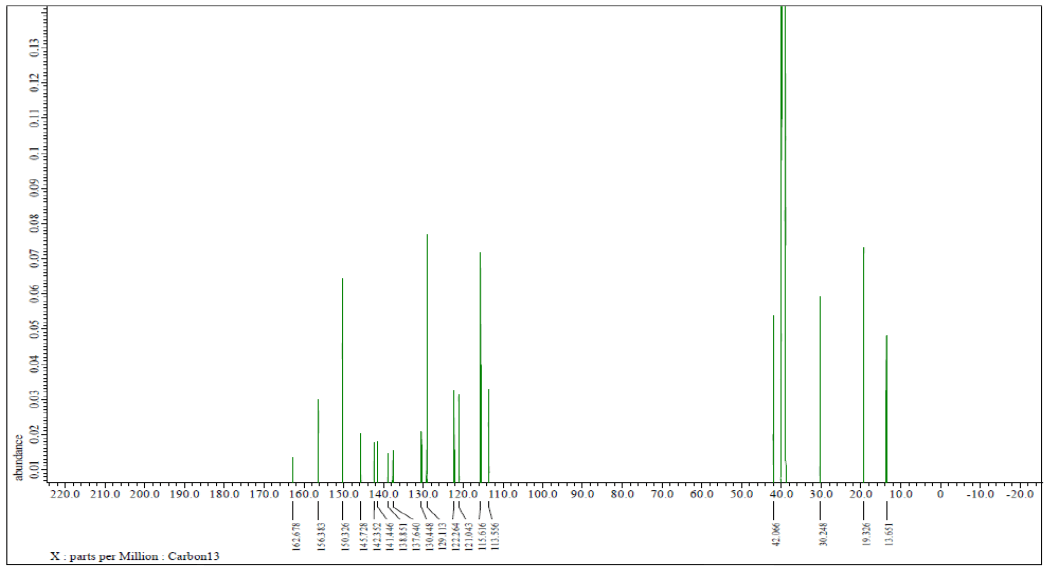
3-(Butylamino)-2-phenoxy-5-(2-(thiophen-2-yl-methylene)-hydrazinecarbonyl)-benzenesulfonamide (4d)
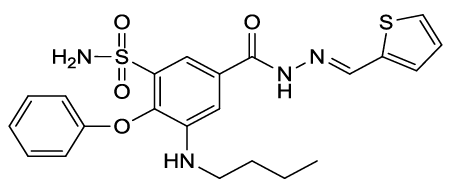
1H-NMR (500 MHz, DMSO-d6) δ (ppm)=0.77 (t, 3H, CH3), 1.13 (m, 2H, CH2), 1.38 (m, 2H, CH2), 2.49 (s, 2H, SO2NH2), 3.10 (q, 2H, CH2- NH), 5.02 (t, 1H, NH), 6.85 (d, 2H, J = 7.5 Hz, Ar-H), 7.00 (t, 1H, J = 7.5 Hz, Ar-H), 7.15 (t, 1H, thiophene), 7.27 (t, 2H, J = 7.5 Hz, Ar-H), 7.39 (s, 1H, Ar-H), 7.48 (d, 1H, thiophene), 7.63 (s, 1H, Ar-H), 7.69 (d, 1H, thiophene), 8.70 (s, 1H, CH=N), 11.92 (s, 1H, CO-NH) ppm.
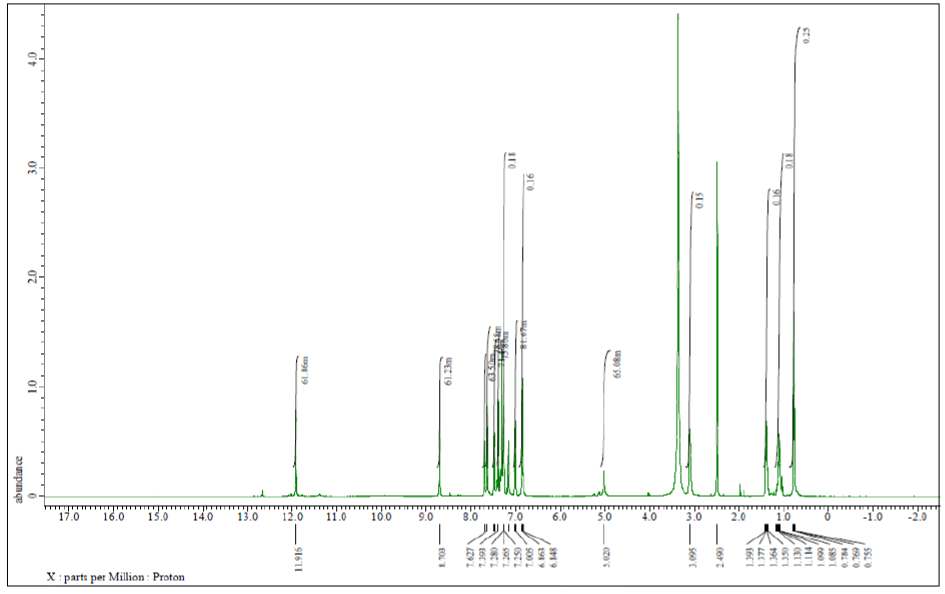
13C-NMR (100 MHz, DMSO-d6) δ (ppm)=13.7 (CH2-CH2-CH2-CH3), 19.3 (CH2-CH2-CH2-CH3), 30.3 (CH2-CH2-CH2-CH3), 42.1 (CH2-CH2- CH2-CH3), 113.4 (Ar-C), 113.5 (Ar-C), 115.6 (2 Ar-C), 122.2 (Ar-C), 127.9 (Ar-C), 129.1 (CH=N), 130.8 (C4-thiophene), 131.1 (2 Ar-C, C5- thiophene), 137.6 (C3-thiophene), 138.6 (Ar-C), 139.1 (Ar-C), 142.3 (C2-thiophene), 143.3 (Ar-C), 156.4 (Ar-C), 162.2 (C=O) ppm.
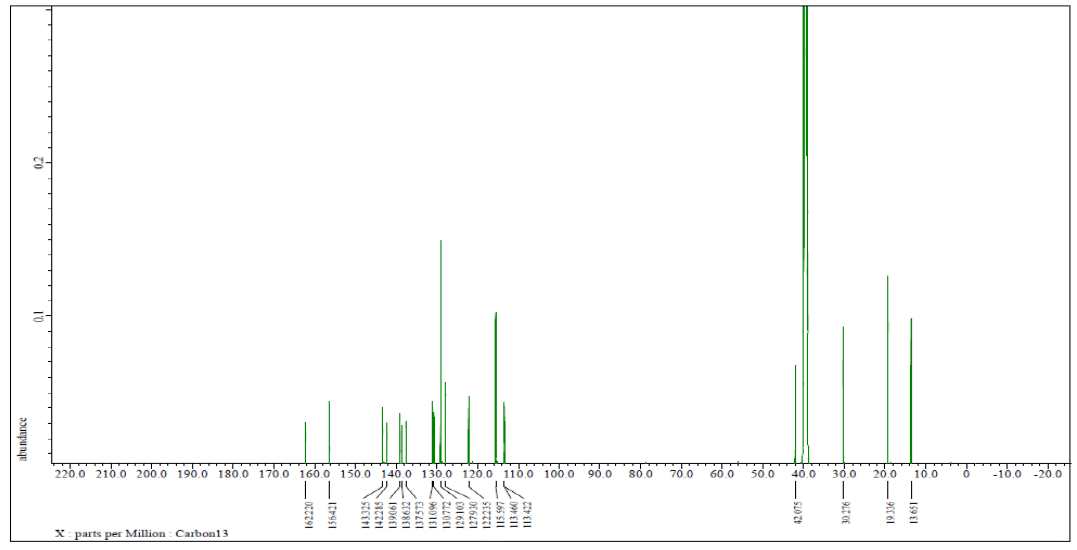
3-(Butylamino)-5-[2-(4-nitrobenzylidene)-hydrazinecarbonyl]-2-phenoxy-benzenesulfonamide (4e)
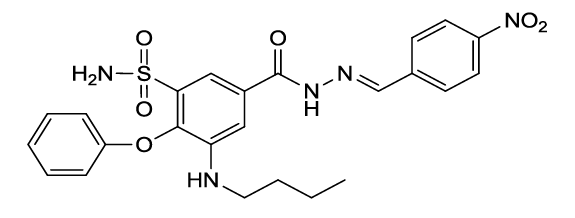
1H-NMR (500 MHz, DMSO-d6) δ (ppm)=0.77 (t, 3H, CH3), 1.10 (m, 2H, CH2), 1.37 (m, 2H, CH2), 2.49 (s, 2H, SO2NH2), 3.09 (q, 2H, CH2- NH), 5.044 (t, 1H, NH), 6.87 (d, 2H, J = 7.5 Hz, Ar-H), 7.01 (t, 1H, J = 7.5 Hz, Ar-H), 7.28 (t, 2H, J = 8 Hz, Ar-H ), 7.33 (s, 1H, Ar-H), 7.58 (s, 1H, Ar-H), 8.11 (d, 2H, J = 8 Hz, Ar-H), 8.28 (d, 2H, J = 8 Hz, Ar-H), 8.77 (s, 1H,CH=N), 11.089 (s, 1H, CO-NH) ppm.
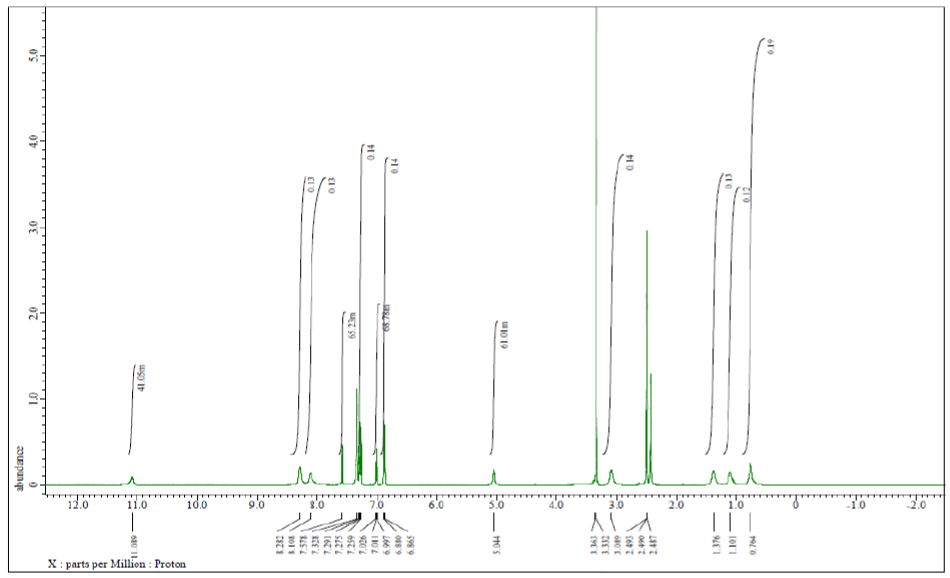
13C-NMR (100 MHz, DMSO-d6) δ (ppm)=13.6 (CH2-CH2-CH2-CH3), 19.3 (CH2-CH2-CH2-CH3), 30.2 (CH2-CH2-CH2-CH3), 42.0 (CH2-CH2- CH2-CH3), 113.8 (Ar-C), 115.6 (Ar-C), 122.2 (2 Ar-C), 123.6 (Ar-C), 127.6 (3 Ar-C), 129.1 (2 Ar-C), 131.3 (3 Ar-C), 138.6 (Ar-C), 142.1 (Ar- C), 144.2 (Ar-C), 147.7 (CH=N), 152.9 (Ar-C), 156.5 (Ar-C), 162.4 (C=O) ppm.
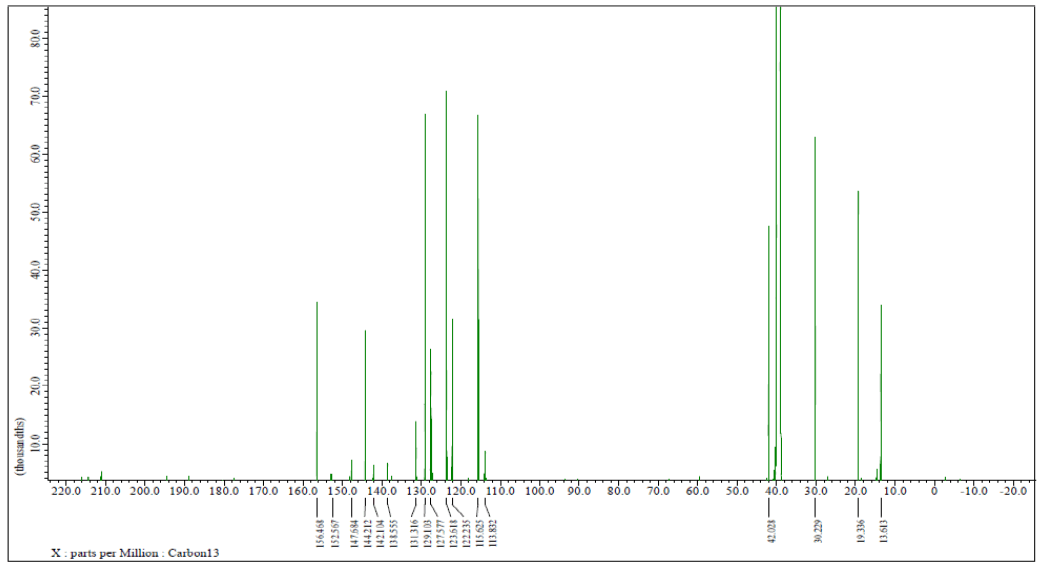
3-(Butylamino)-5-[2-(4-methoxybenzylidene)-hydrazinecarbonyl]-2-phenoxy-benzenesulfonamide (4f)
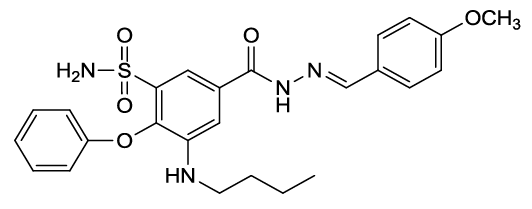
1H-NMR (500 MHz, DMSO-d6) δ (ppm)=0.77 (t, 3H, CH3), 1.13 (m, 2H, CH2), 1.38 (m, 2H, CH2), 2.49 (s, 2H, SO2NH2), 3.09 (q, 2H, CH2- NH), 3.81 (s, 3H, OCH3), 5.00 (t, 1H, NH), 6.85 (d, 2H, J = 8.5 Hz, Ar-H), 7.02 (t, 1H, J = 8 Hz, Ar-H), 7.03 (d, 2H, J = 8.5 Hz, Ar-H), 7.27 (t, 2H, J = 8 Hz, Ar-H), 7.31 (s, 1H, Ar-H), 7.65 (s, 1H, Ar-H), 7.68 (d, 2H, J = 8.5 Hz, Ar-H), 8.43 (s, 1H, CH=N), 11.84 (s, 1H, CO-NH) ppm.
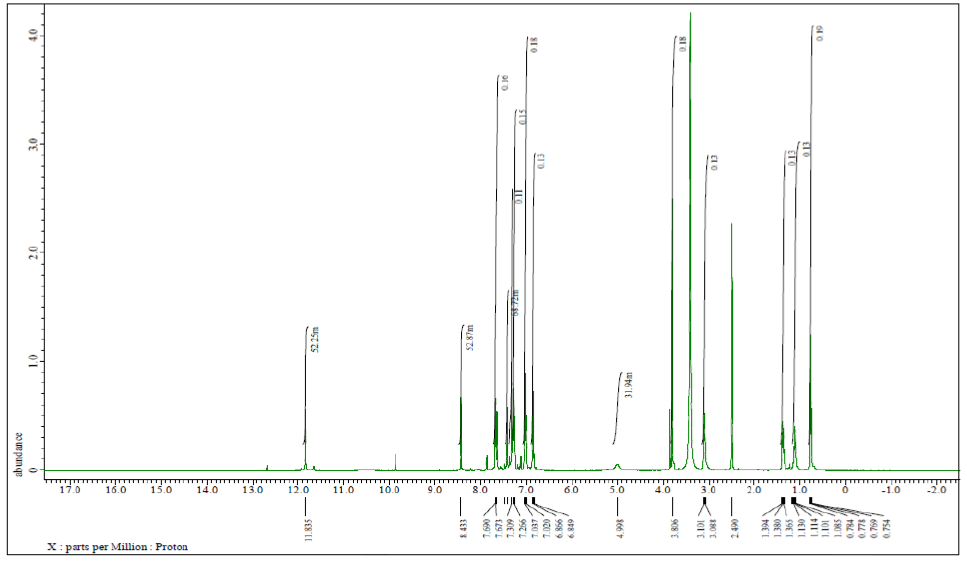
13C-NMR (100 MHz, DMSO-d6) δ (ppm)=13.7 (CH2-CH2-CH2-CH3), 19.3 (CH2-CH2-CH2-CH3), 30.3 (CH2-CH2-CH2-CH3), 42.1 (CH2-CH2- CH2-CH3), 55.3 (OCH3), 113.5 (Ar-C), 114.4 (Ar-C), 115.6 (2 Ar-C), 122.2 (2 Ar-C), 126.8 (Ar-C), 128.8 (Ar-C), 129.1 (Ar-C), 131.0 (2 Ar-C), 131.8 (2 Ar-C), 137.5 (Ar-C), 138.6 (Ar-C), 142.3 (Ar-C), 148.1 (CH=N), 156.4 (Ar-C), 160.9 (Ar-C), 162.2 (C=O) ppm.
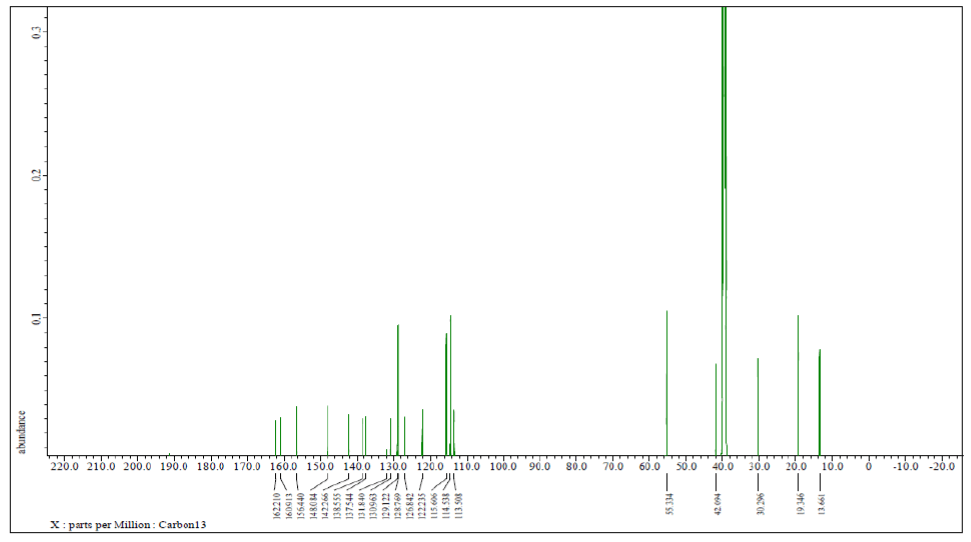
3-(butylamino)-5-[2-(4-chlorobenzylidene)-hydrazinecarbonyl]-2-phenoxy-benzenesulfonamide (4g)
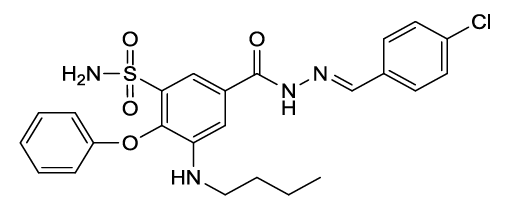
1H-NMR (500 MHz, DMSO-d6) δ (ppm)=0.77 (t, 3H, CH3), 1.12 (m, 2H, CH2), 1.38 (m, 2H, CH2), 2.49 (s, 2H, SO2NH2), 3.11 (q, 2H, CH2- NH), 5.03 (t, 1H, NH), 6.86 (d, 2H, J = 7.5 Hz, Ar-H), 7.01 (t, 1H, J = 7.5 Hz, Ar-H), 7.27 (t, 2H, J = 7.5 Hz, Ar-H ), 7.40 (s, 1H, Ar-H), 7.53 (d, 2H, J = 8.5 Hz, Ar-H), 7.65 (s, 1H, Ar-H), 7.77 (d, 2H, J = 8.5 Hz, Ar-H), 8.47 (s, 1H,CH=N), 12.00 (s, 1H, CO-NH) ppm.
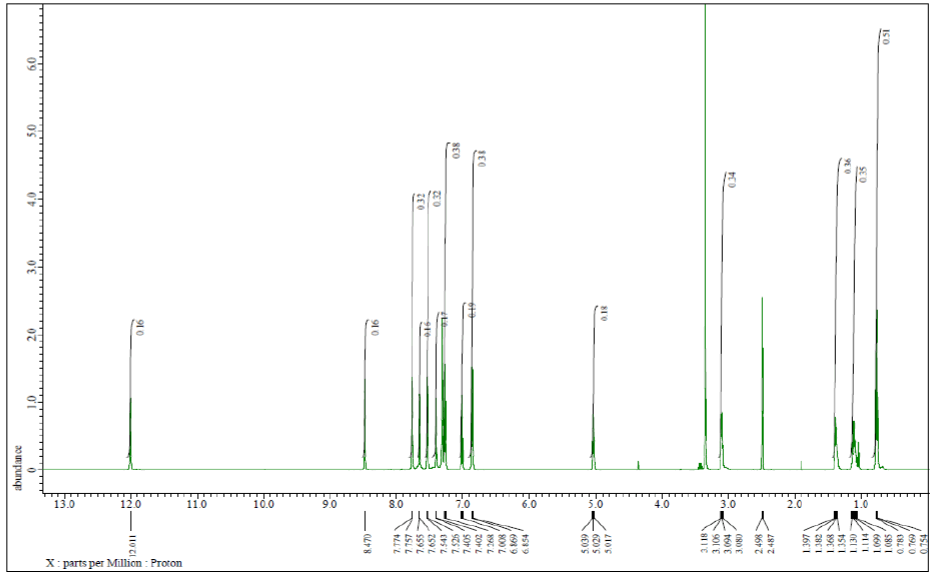
13C-NMR (100 MHz, DMSO-d6) δ (ppm)=13.6 (CH2-CH2-CH2-CH3), 19.3 (CH2-CH2-CH2-CH3), 30.3 (CH2-CH2-CH2-CH3), 42.1 (CH2-CH2- CH2-CH3), 113.5 (Ar-C), 115.6 (Ar-C), 122.2 (2 Ar-C), 128.8 (Ar-C), 129.0 (Ar-C), 129.1 (3 Ar-C), 130.7 (2 Ar-C), 133.2 (2 Ar-C), 134.6 (Ar- C), 137.6 (Ar-C), 138.7 (Ar-C), 142.3 (Ar-C), 146.8 (CH=N), 156.4 (Ar-C), 162.4 (C=O) ppm.
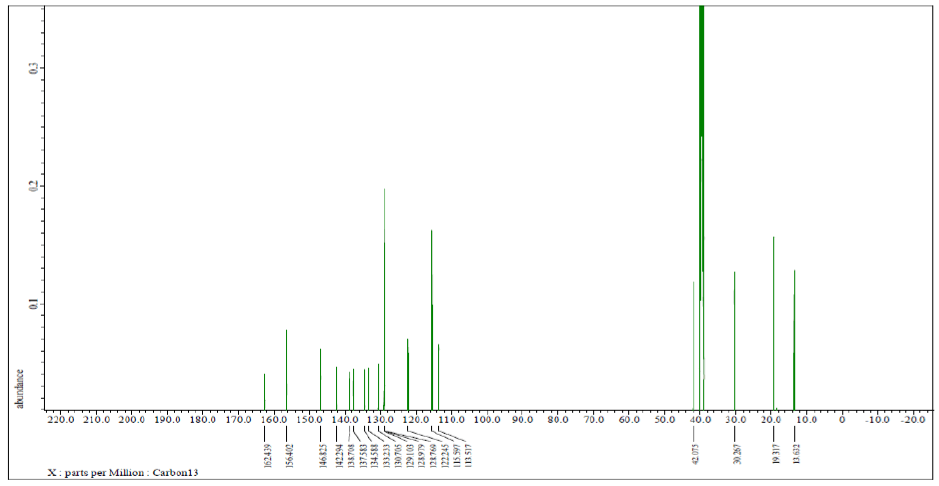
5-{2-[4-(benzyloxy)-benzylidene]-hydrazinecarbonyl}-3-(butylamino)-2-phenoxy-benzenesulfonamide (4h)
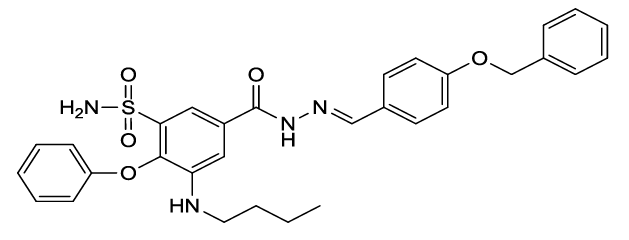
1H-NMR (500 MHz, DMSO-d6) δ (ppm)=0.76 (t, 3H, CH3), 1.11 (m, 2H, CH2), 1.37 (m, 2H, CH2), 2.49 (s, 2H, SO2NH2), 3.09 (q, 2H, CH2- NH), 5.02 (t, 1H, NH), 5.13 (s, 2H, CH2-O), 6.85 (d, 2H, J = 7.5 Hz, Ar-H), 6.99 (t, 1H, J = 6.5 Hz, Ar-H), 7.01 (d, 2H, J = 8.5 Hz, Ar-H), 7.16 (t, 1H, J = 6.5 Hz, Ar-H), 7.26 (t, 2H, J = 8 Hz, Ar-H), 7.30 (s, 1H, Ar-H), 7.38 (t, 2H, J = 7 Hz, Ar-H), 7.43 (d, 2H, J = 7 Hz, Ar-H), 7.68 (s, 1H, Ar-H), 7.70 (d, 2H, J = 8.5 Hz, Ar-H), 10.65 (s, 1H, CH=N), 11.748 (s, 1H, CO-NH) ppm.
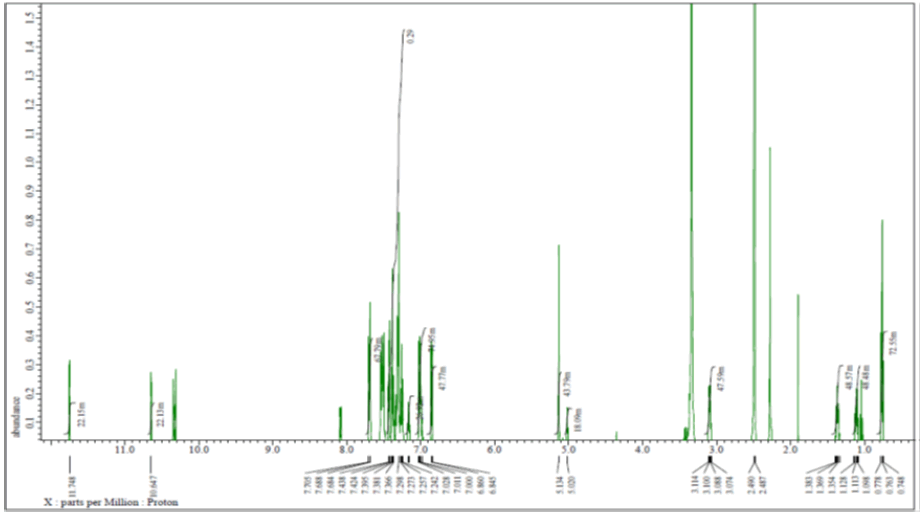
13C-NMR (100 MHz, DMSO-d6) δ (ppm)=13.7 (CH2-CH2-CH2-CH3), 19.4 (CH2-CH2-CH2-CH3), 30.3 (CH2-CH2-CH2-CH3), 42.0 (CH2-CH2- CH2-CH3), 69.3 (O-CH2), 113.8 (Ar-C), 115.1 (Ar-C), 115.6 (2 Ar-C), 118.6 (2 Ar-C), 122.2 (Ar-C), 126.9 (Ar-C), 127.7 (Ar-C), 128.5 (2 Ar- C), 129.1 (Ar-C), 129.9 (2 Ar-C), 130.1 (2 Ar-C), 131.4 (2 Ar-C), 136.0 (Ar-C), 136.8 (Ar-C), 138.6 (Ar-C), 139.3 (Ar-C), 143.9 (CH=N), 156.4 (Ar-C), 164.4 (Ar-C), 168.4 (C=O) ppm.
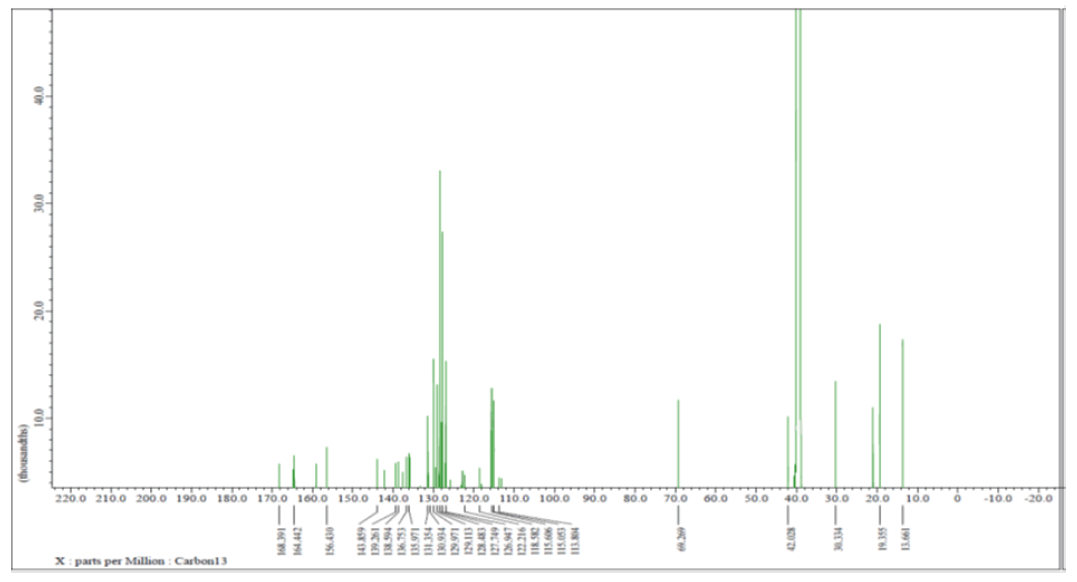
3-(Butylamino)-2-phenoxy-5-[2-(3,4,5-trimethoxybenzylidene)-hydrazinecarbonyl]-benzenesulfonamide (4i)
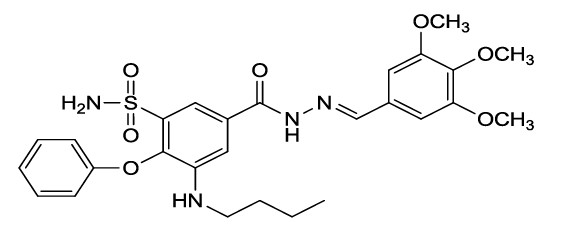
1H-NMR (500 MHz, DMSO-d6) δ (ppm)=0.78 (t, 3H, CH3), 1.11 (m, 2H, CH2), 1.39 (m, 2H, CH2), 2.49 (s, 2H, SO2NH2), 3.10 (q, 2H, CH2- NH), 3.71 (s, 3H, OCH3), 3.84 (s, 6H, 2OCH3), 5.02 (t, 1H, NH), 6.86 (d, 2H, J = 8 Hz, Ar-H), 7.01 (t, 1H, J = 7.5 Hz, Ar-H), 7.03 (s, 2H, Ar- H), 7.27 (t, 2H, J = 8 Hz, Ar-H), 7.39 (s, 1H, Ar-H), 7.64 (s, 1H, Ar-H), 8.41 (s, 1H, CH=N), 11.91 (s, 1H, CO-NH) ppm.
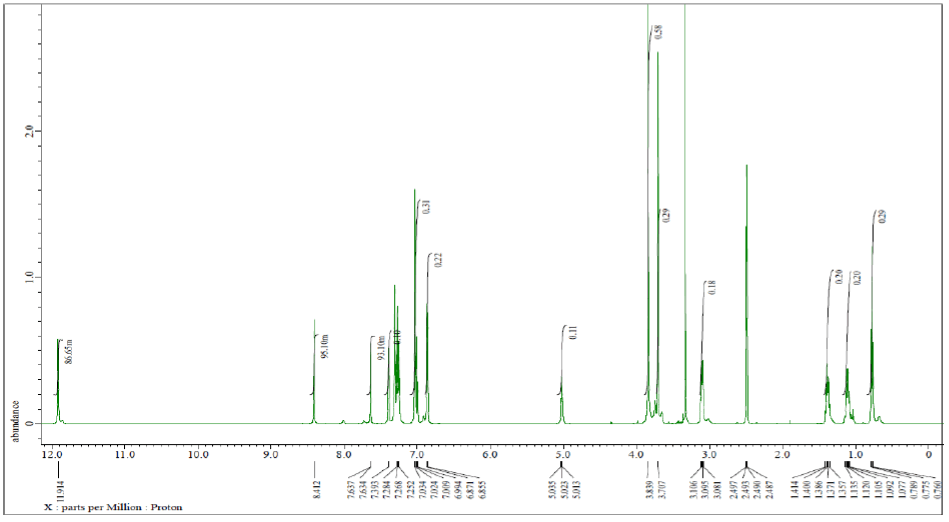
13C-NMR (100 MHz, DMSO-d6) δ (ppm)=13.6 (CH2-CH2-CH2-CH3), 19.3 (CH2-CH2-CH2-CH3), 30.3 (CH2-CH2-CH2-CH3), 42.1 (CH2-CH2- CH2-CH3), 56.0 (3, 5 OCH3), 60.1 (4 OCH3), 104.3 (2 Ar-C), 113.5 (Ar-C), 115.6 (Ar-C), 122.2 (2 Ar-C), 129.1 (Ar-C), 129.8 (Ar-C), 130.9 (Ar-C), 137.6 (3 Ar-C), 138.6 (Ar-C), 139.3 (Ar-C), 142.2 (Ar-C), 148.2 (CH=N), 153.2 (2 Ar-C), 156.4 (Ar-C), 162.4 (C=O) ppm.
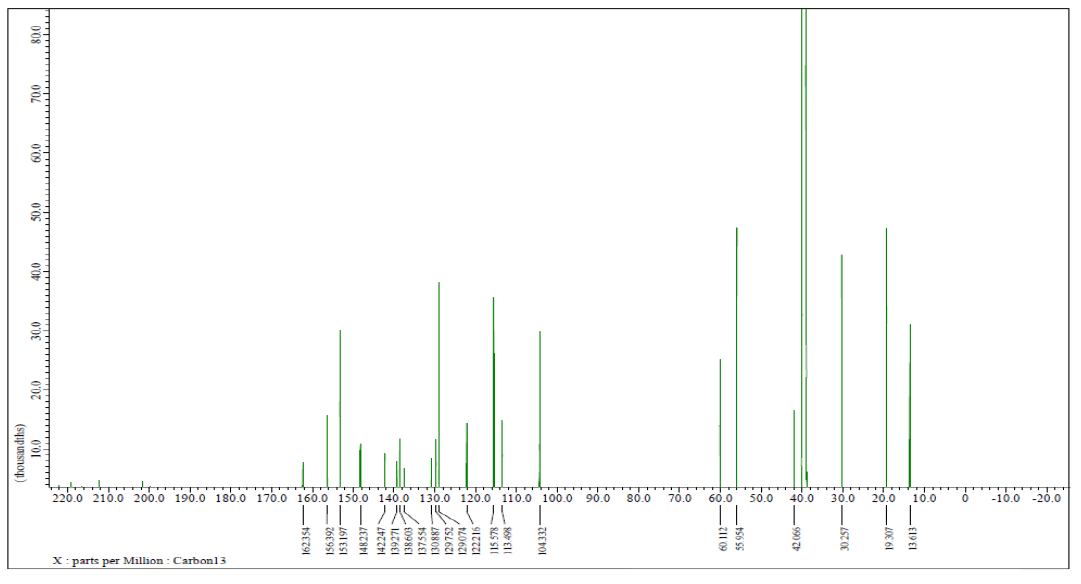
3-(Butylamino)-2-phenoxy-5-(5-phenyl-1,3,4-oxadiazol-2-yl)-benzenesulfonamide (5a)
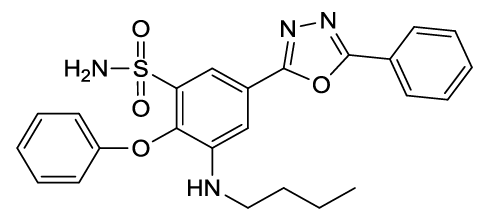
1H-NMR (500 MHz, DMSO-d6) δ (ppm)=0.77 (t, 3H, CH3), 1.11 (m, 2H, CH2), 1.38 (m, 2H, CH2), 2.49 (s, 2H, SO2NH2), 3.06 (q, 2H, CH2- NH), 4.66 (t, 1H, NH), 6.80 (d, 2H, J = 8 Hz, Ar-H), 6.94 (t, 1H, J = 8 Hz, Ar-H), 7.21 (t, 2H, J = 8 Hz, Ar-H), 7.27 (d, 2H, J = 7 Hz, Ar-H), 7.33 (s, 1H, Ar-H), 7.54 (t, 1H, J = 7 Hz, Ar-H), 7.64 (s, 1H, Ar-H), 7.80 (t, 2H, J = 7 Hz, Ar-H) ppm.
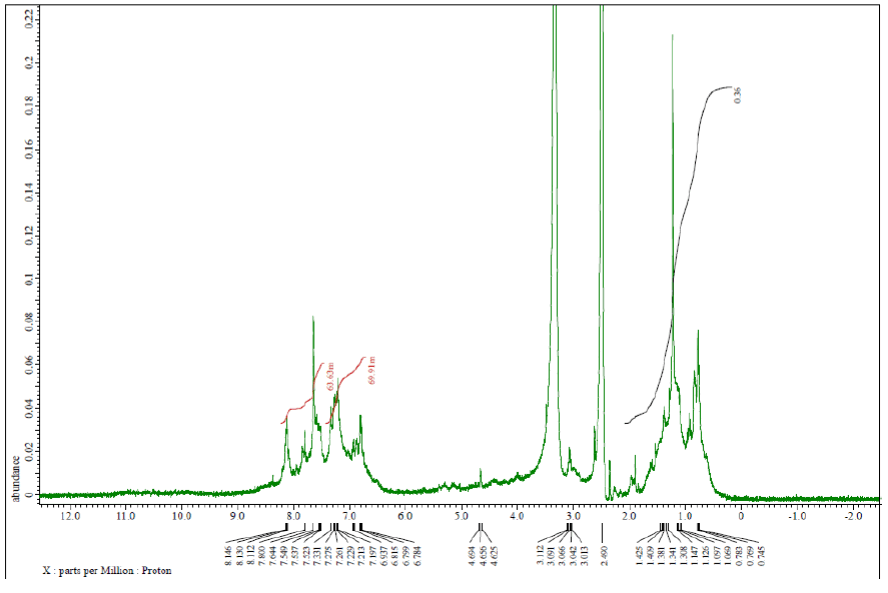
3-(Butylamino)-5-[5-(4-chlorophenyl)-1,3,4-oxadiazol-2-yl]-2-phenoxy-benzenesulfonamide (5b)
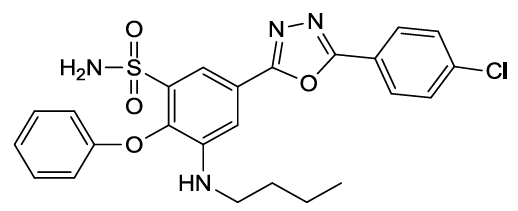
1H-NMR (500 MHz, DMSO-d6) δ (ppm)=0.77 (t, 3H, CH3), 1.09 (m, 2H, CH2), 1.25 (m, 2H, CH2), 2.49 (s, 2H, SO2NH2), 3.08 (q, 2H, CH2- NH), 4.91 (t, 1H, NH), 6.82 (d, 2H, J = 8 Hz, Ar-H), 7.06 (t, 1H, J = 8.5 Hz, Ar-H), 7.14 (d, 2H, J = 7.5 Hz, Ar-H), 7.23 (s, 1H, Ar-H), 7.29 (t, 2H, J = 8 Hz, Ar-H), 7.59 (s, 1H, Ar-H), 7.83 (d, 2H, J = 8 Hz, Ar-H) ppm.
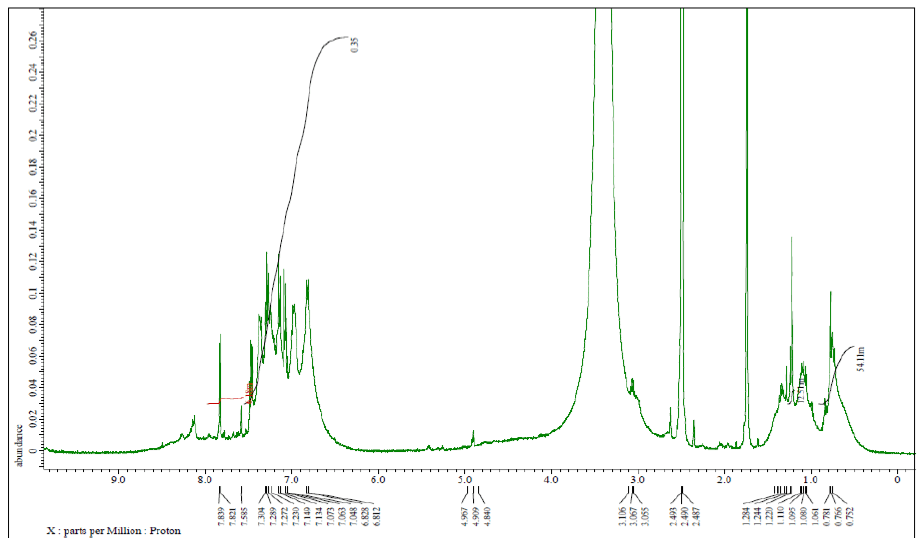
13C-NMR (100 MHz, DMSO-d6) δ (ppm)=14.0 (CH2-CH2-CH2-CH3), 19.9 (CH2-CH2-CH2-CH3), 30.4 (CH2-CH2-CH2-CH3), 42.7 (CH2-CH2- CH2-CH3), 112.7 (Ar-C), 116.3 (Ar-C), 117.9 (2 Ar-C), 118.5 (Ar-C), 119.5 (Ar-C), 125.9 (2 Ar-C), 129.6 (2 Ar-C), 129.8 (2 Ar-C), 130.7 (Ar- C), 135.1 (Ar-C), 145.3 (Ar-C), 147.2 (Ar-C), 152.1 (Ar-C), 156.1 (Ar-C), 161.5 (C5-oxadiazole), 161.8 (C2-oxadiazole) ppm.
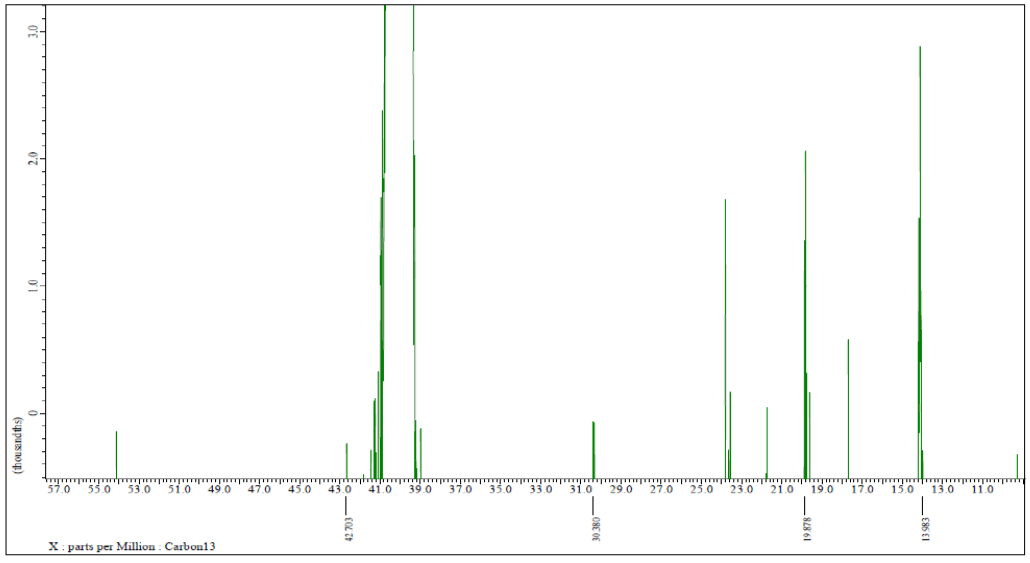

3-(Butylamino)-5-[5-(4-nitrophenyl)-1,3,4-oxadiazol-2-yl]-2-phenoxy-benzenesulfonamide (5c)
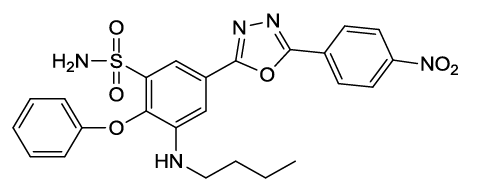
1H-NMR (500 MHz, DMSO-d6) δ (ppm)=0.77 (t, 3H, CH3), 1.06 (m, 2H, CH2), 1.30 (m, 2H, CH2), 2.49 (s, 2H, SO2NH2), 3.05 (q, 2H, CH2- NH), 5.21 (t, 1H, NH), 6.88 (d, 2H, J = 8.5 Hz, Ar-H), 7.01 (t, 1H, J = 8 Hz, Ar-H), 7.28 (t, 2H, J = 7.5 Hz, Ar-H), 7.53 (s, 1H, Ar-H), 7.73 (d, 2H, J = 8.5 Hz, Ar-H), 7.80 (s, 1H, Ar-H), 8.16 (d, 2H, J = 7 Hz, Ar-H) ppm.
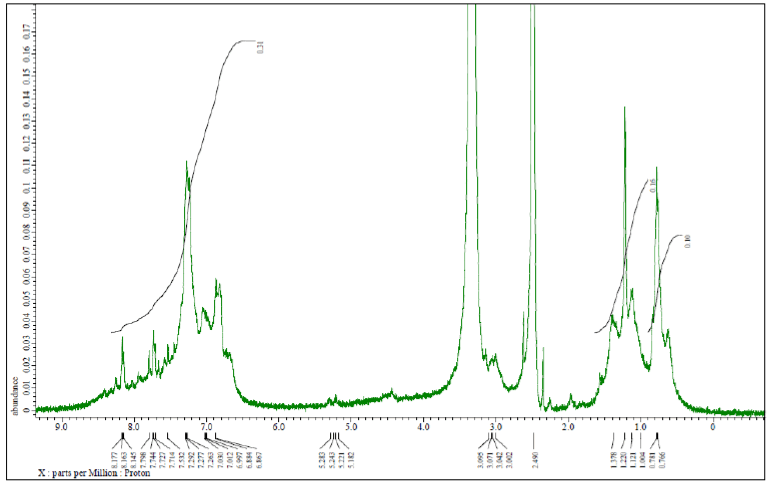
13C-NMR (100 MHz, DMSO-d6) δ (ppm)=13.6 (CH2-CH2-CH2-CH3), 19.3 (CH2-CH2-CH2-CH3), 30.6 (CH2-CH2-CH2-CH3), 42.2 (CH2-CH2- CH2-CH3), 128.3 (Ar-C), 129.1 (Ar-C), 130.3 (2 Ar-C), 131.8 (Ar-C), 134.7 (Ar-C), 136.4 (Ar-C), 136.7 (2 Ar-C), 137.7 (2 Ar-C), 138.8 (2 Ar- C), 139.6 (Ar-C), 146.4 (Ar-C), 147.6 (Ar-C), 151.9 (Ar-C), 156.3 (Ar-C), 161.9 (C5-oxadiazole), 162.5 (C2-oxadiazole) ppm.
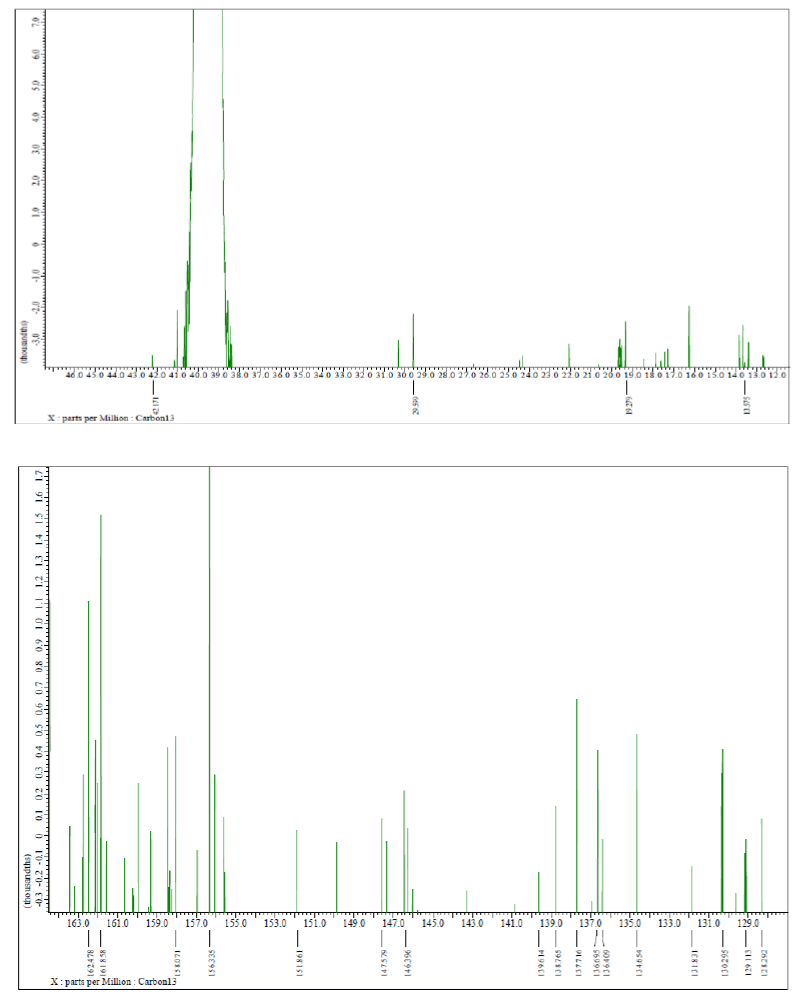
3-(Butylamino)-2-phenoxy-5-[5-(4-phenoxyphenyl)-1,3,4-oxadiazol-2-yl]-benzenesulfonamide (5d)
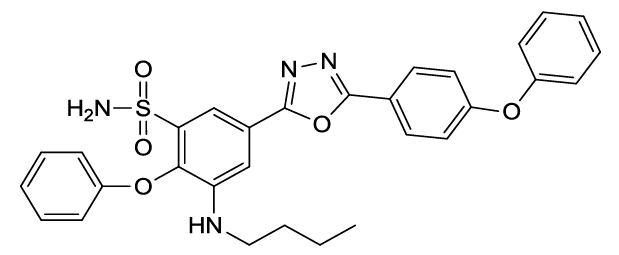
1H-NMR (500 MHz, DMSO-d6) δ (ppm)=0.77 (t, 3H, CH3), 1.14 (m, 2H, CH2), 1.35 (m, 2H, CH2), 2.49 (s, 2H, SO2NH2), 3.07 (q, 2H, CH2- NH), 4.92 (t, 1H, NH), 6.82 (d, 4H, J = 8.5 Hz, Ar-H), 6.99 (t, 1H, J = 7.5 Hz, Ar-H), 7.09 (t, 1H, J = 7.5 Hz, Ar-H), 7.21 (s, 1H, Ar-H), 7.25 (t, 2H, J = 7 Hz, Ar-H), 7.33 (t, 2H, J = 7.5 Hz, Ar-H), 7.57 (d, 2H, J = 8.5 Hz, Ar-H), 7.68 (s, 1H, Ar-H), 8.01(d, 2H, J = 8.5 Hz, Ar-H) ppm.
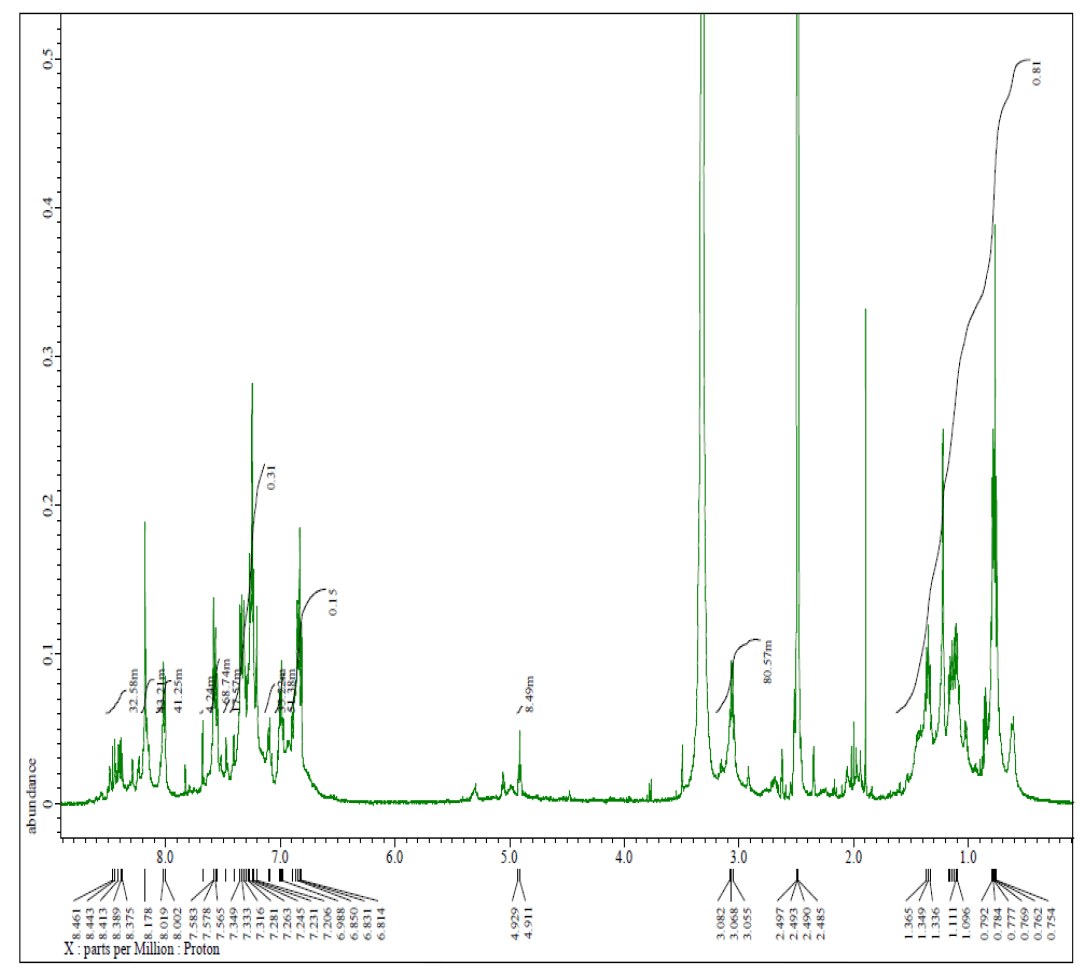
13C-NMR (100 MHz, DMSO-d6) δ (ppm)=13.6 (CH2-CH2-CH2-CH3), 19.3 (CH2-CH2-CH2-CH3), 30.4 (CH2-CH2-CH2-CH3), 42.0 (CH2-CH2- CH2-CH3), 115.5 (Ar-C), 122.1 (Ar-C), 122.8 (2 Ar-C), 129.1 (2 Ar-C), 129.3 (4 Ar-C), 129.6 (Ar-C), 139.1 (2 Ar-C), 147.1 (Ar-C), 148.3 (4 Ar-C), 156.7 (Ar-C), 157.1 (3 Ar-C), 157.9 (Ar-C), 159.4 (Ar-C), 162.8 (C5-oxadiazole), 165.1 (C2-oxadiazole) ppm.
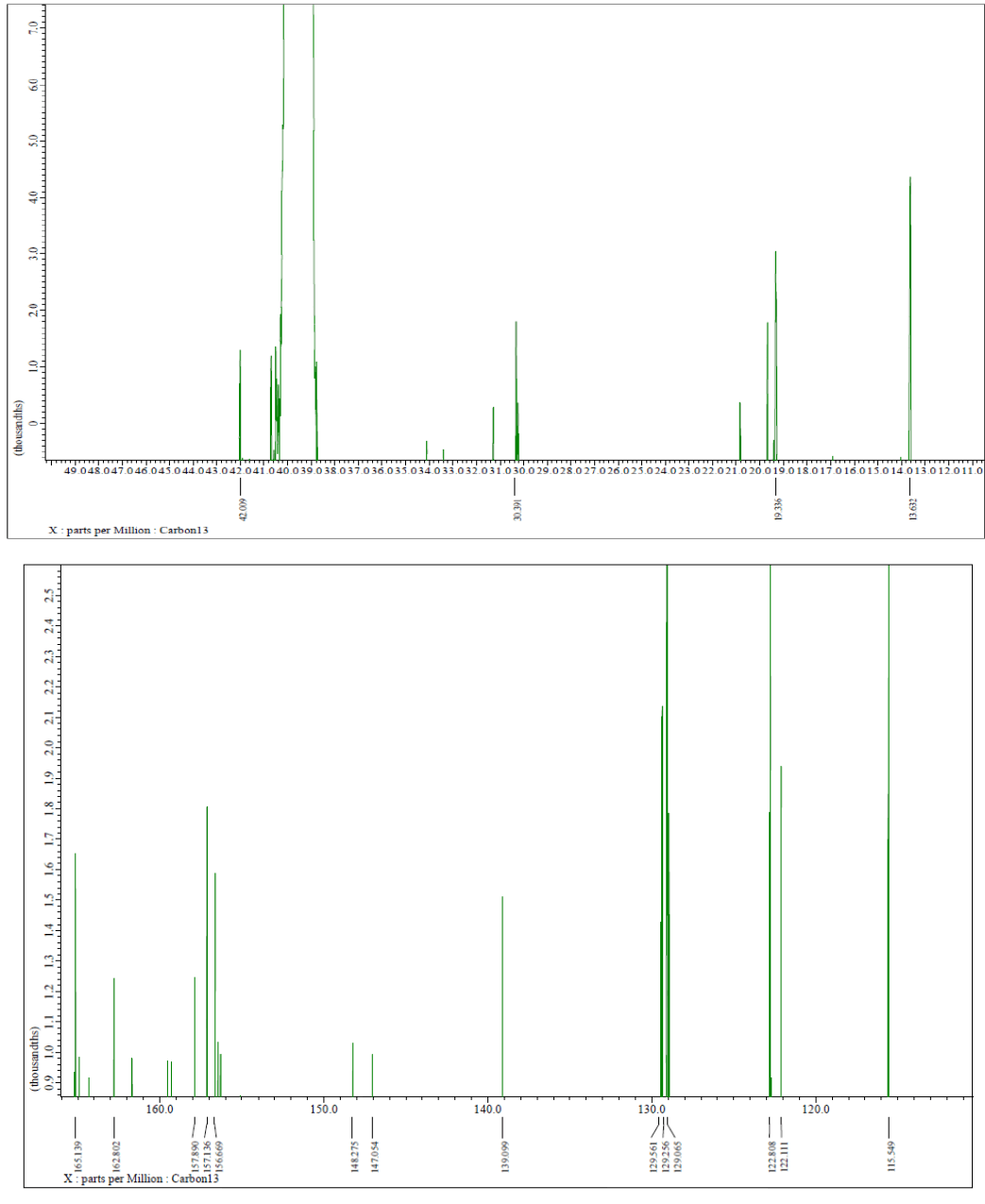
3-(Butylamino)-2-phenoxy-5-[5-(pyridin-3-yl)-1,3,4-oxadiazol-2-yl]-benzenesulfonamide (5e)
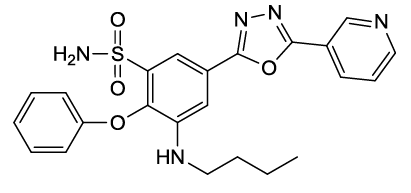
1H-NMR (500 MHz, DMSO-d6) δ (ppm)=0.78 (t, 3H, CH3), 1.10 (m, 2H, CH2), 1.38 (m, 2H, CH2), 2.49 (s, 2H, SO2NH2), 3.08 (q, 2H, CH2- NH), 4.67 (t, 1H, NH), 6.81 (d, 2H, J = 8 Hz, Ar-H), 6.94 (t, 1H, J = 7.5 Hz, Ar-H), 7.20 (t, 2H, J = 7.5 Hz, Ar-H), 7.37 (s, 1H, Ar-H), 7.68 (t, 1H, J = 8.5 Hz, pyridine), 7.83 (s, 1H, Ar-H), 8.50 (d, 2H, J = 7 Hz, pyridine), 9.32 (s, 1H, pyridine) ppm.
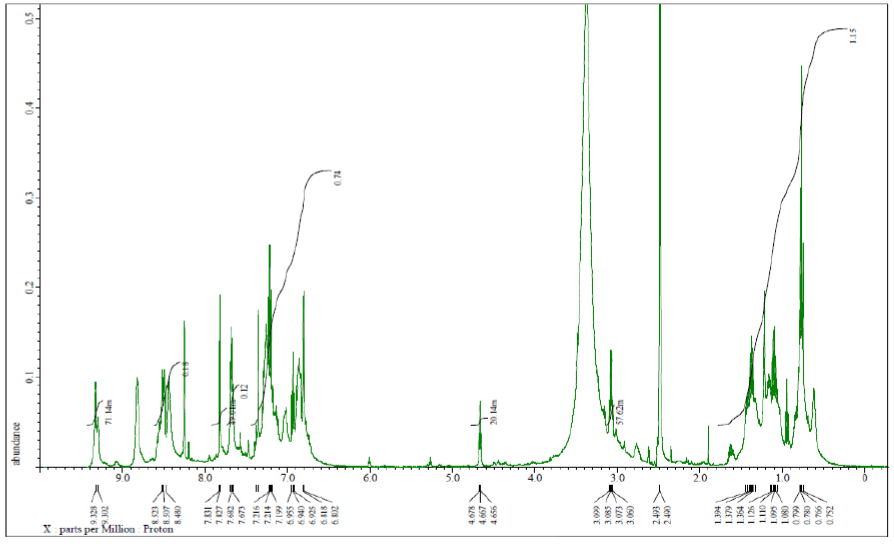
13C-NMR (100 MHz, DMSO-d6) δ (ppm)=13.6 (CH2-CH2-CH2-CH3), 19.3 (CH2-CH2-CH2-CH3), 30.3 (CH2-CH2-CH2-CH3), 42.2 (CH2-CH2- CH2-CH3), 114.5 (Ar-C), 115.8 (Ar-C), 119.2 (2 Ar-C), 121.4 (Ar-C), 124.4 (Ar-C), 128.9 (C3, C5-pyridine), 130.0 (Ar-C), 134.3 (2 Ar-C), 134.4 (C4-pyridine), 142.6 (Ar-C), 147.4 (Ar-C), 150.2 (C6-pyridine), 152.3 (C2-pyridine), 156.9 (C6-pyridine), 162.6 (C5-oxadiazole), 167.4 (C2-oxadiazole) ppm.
